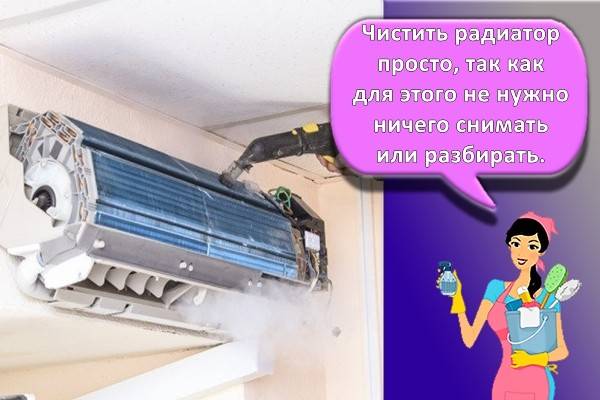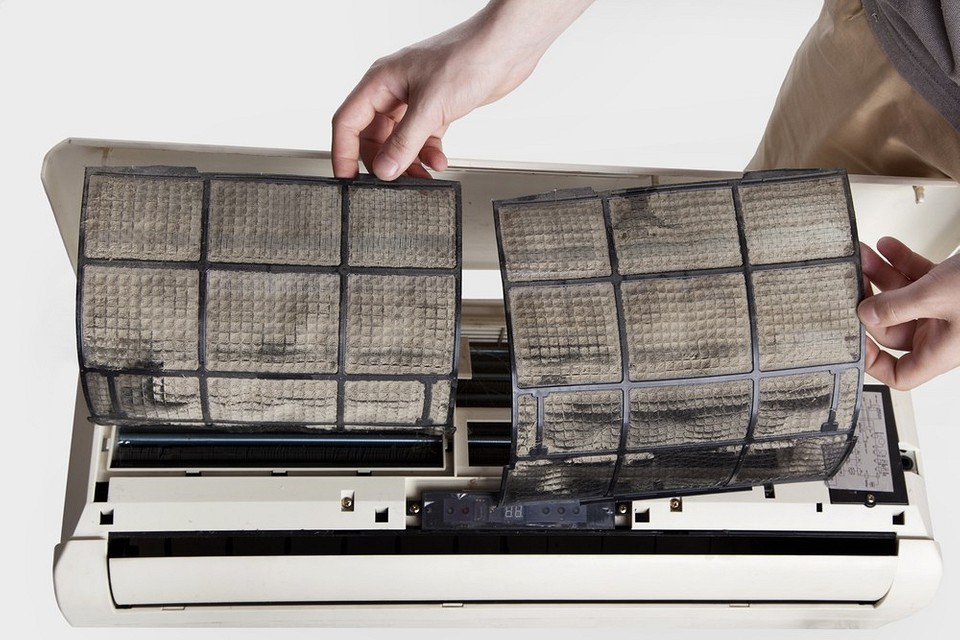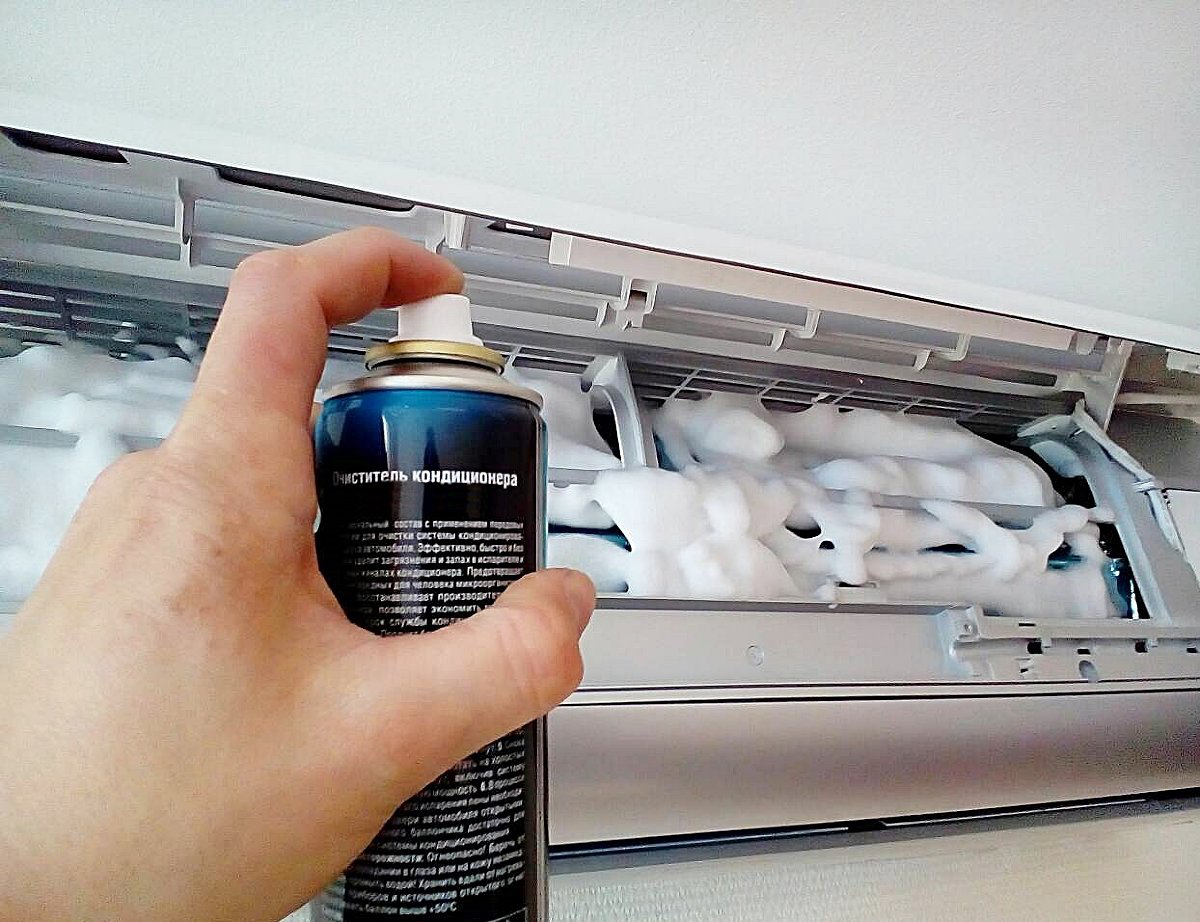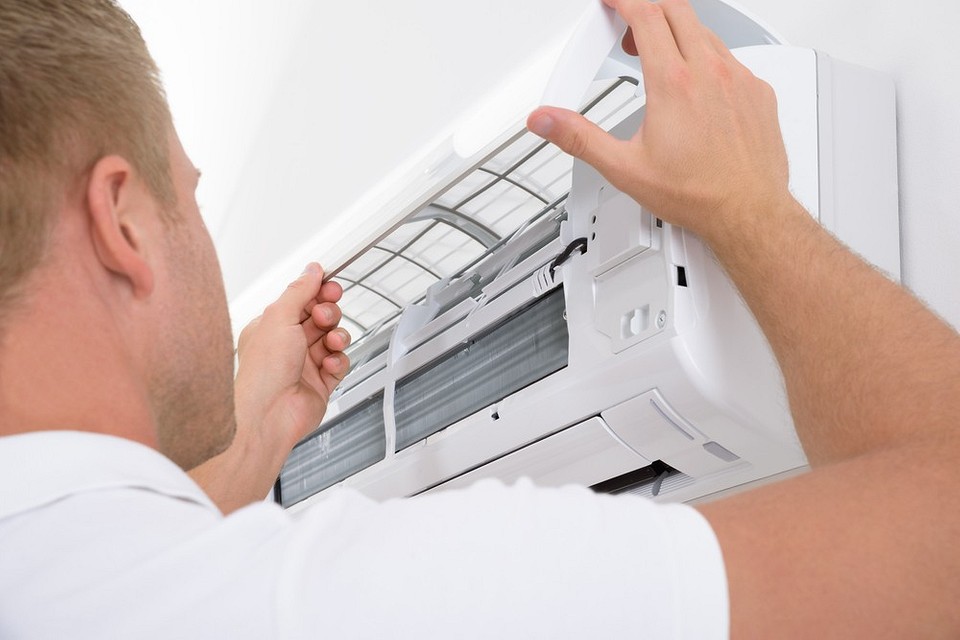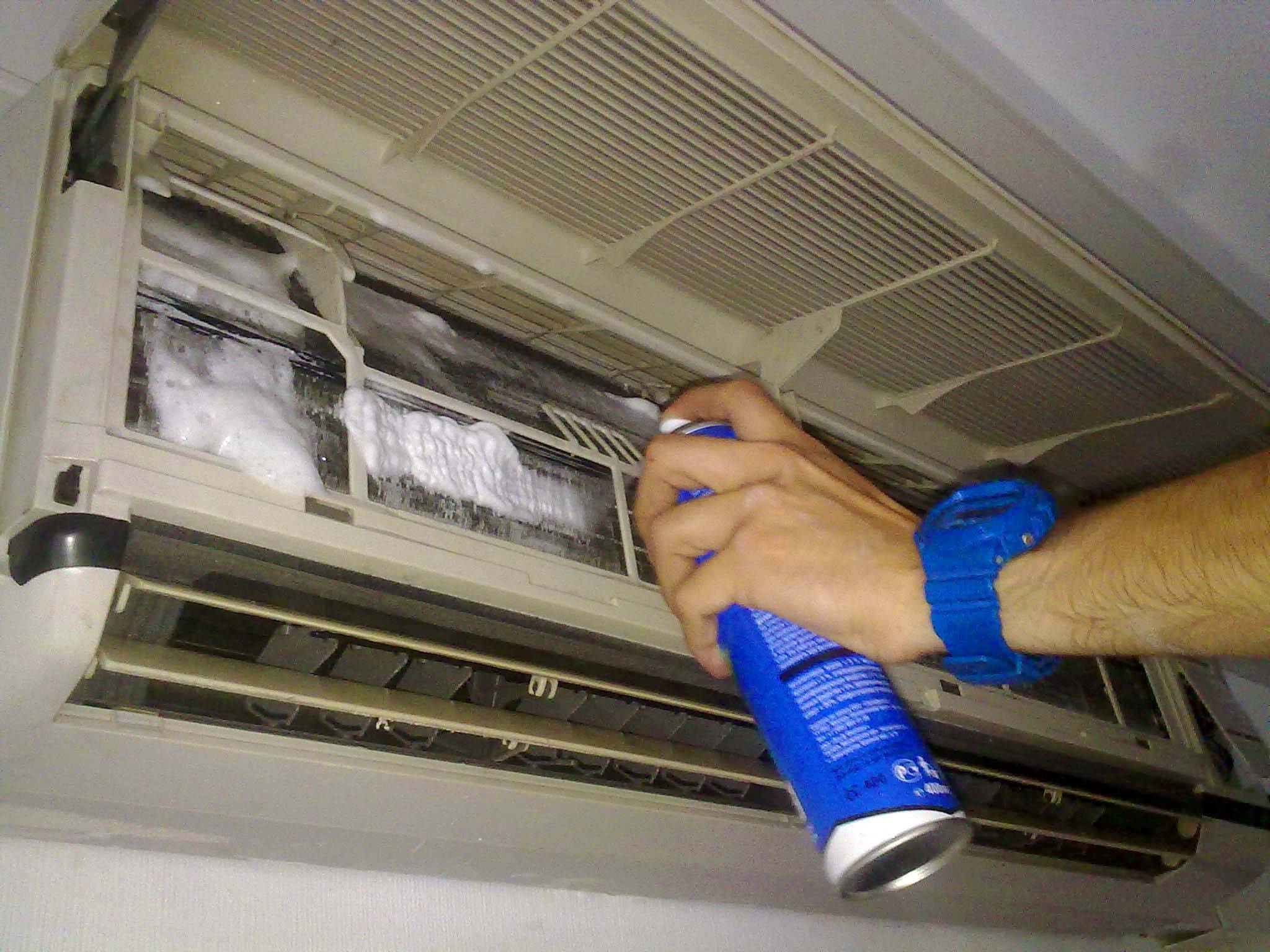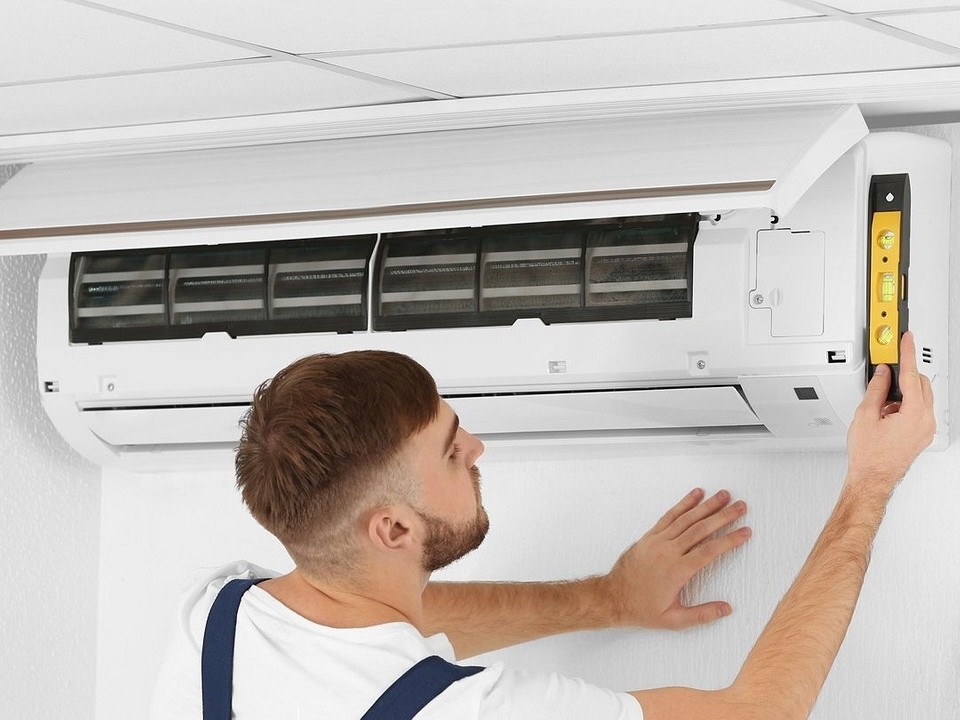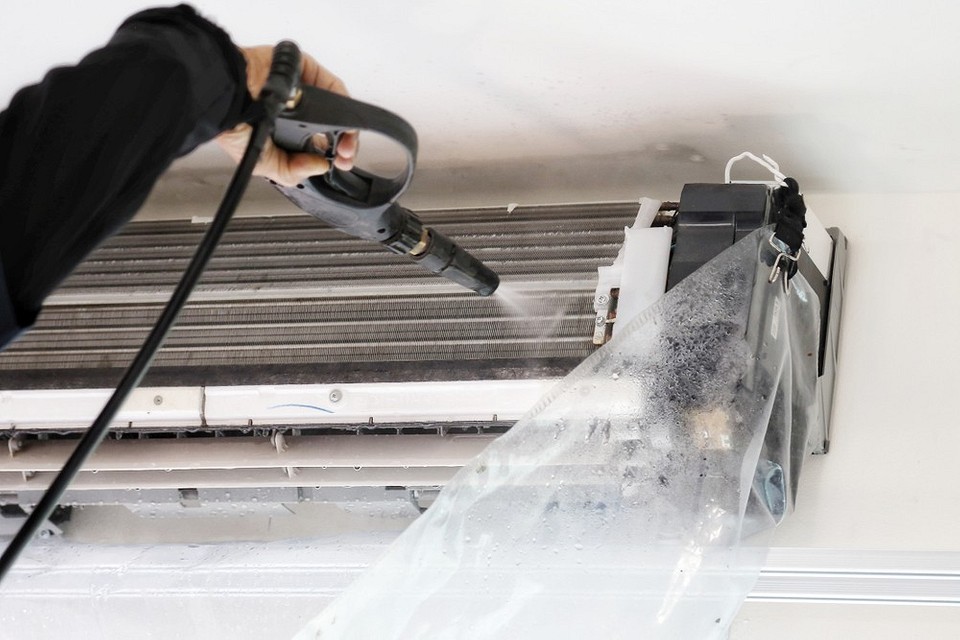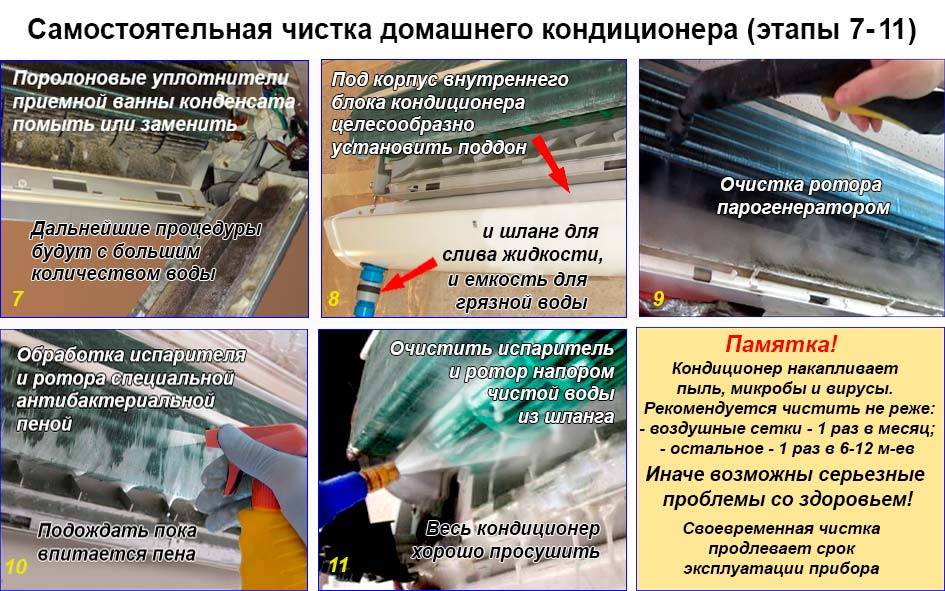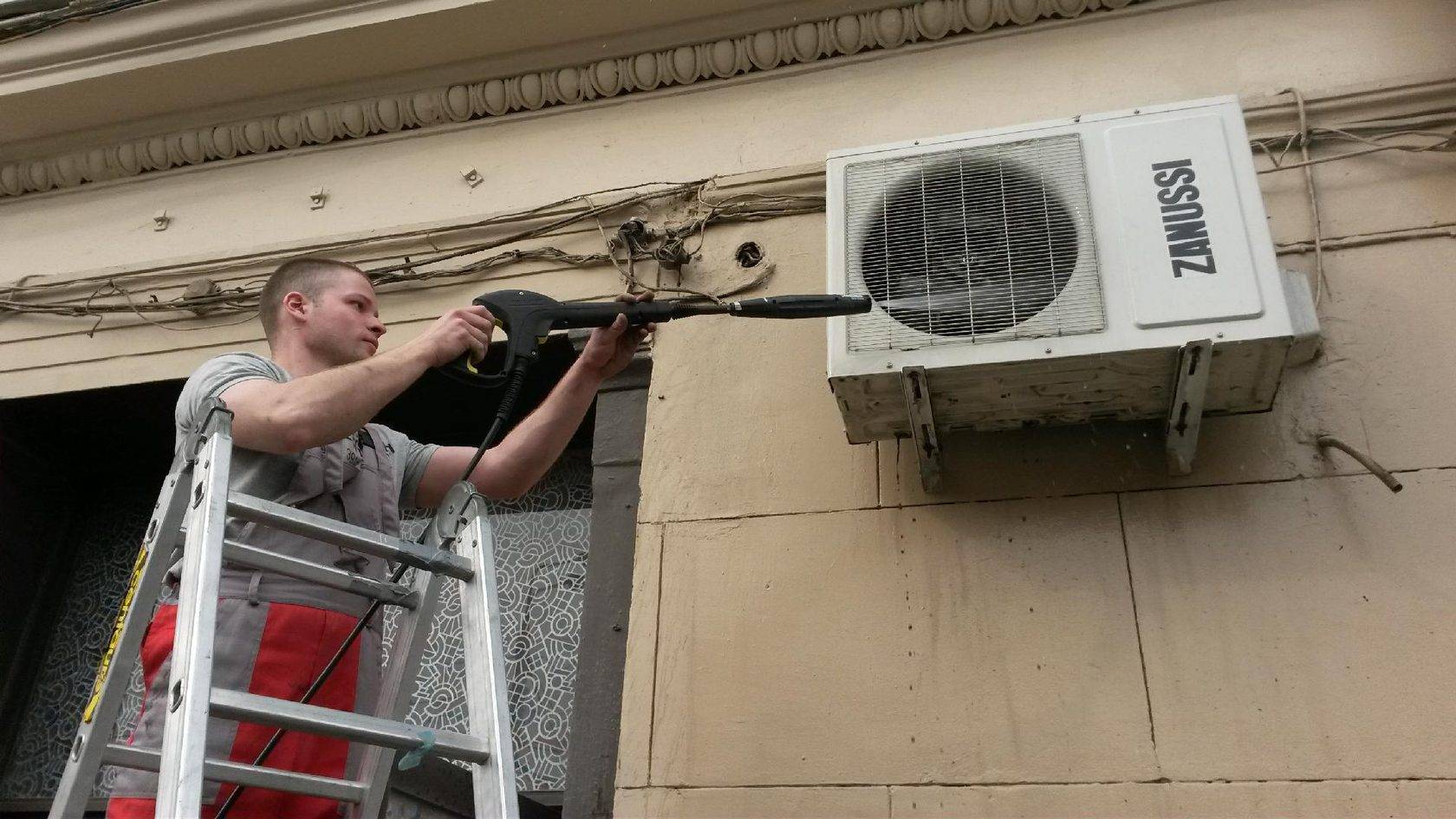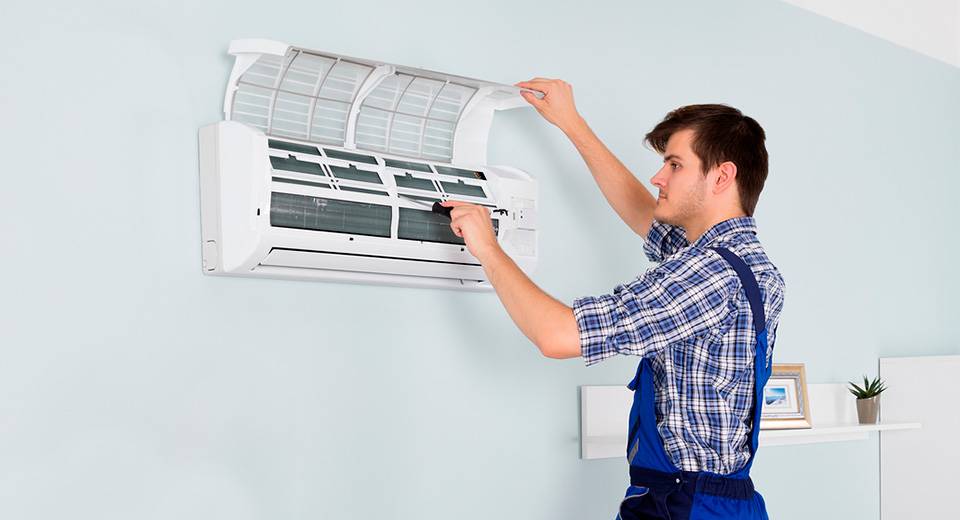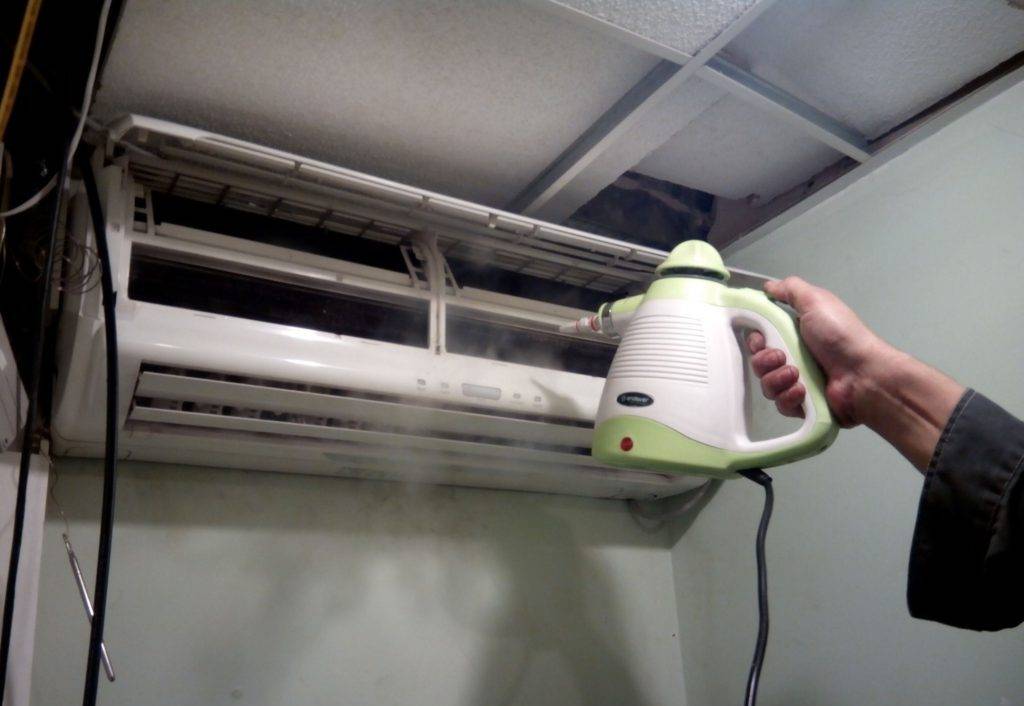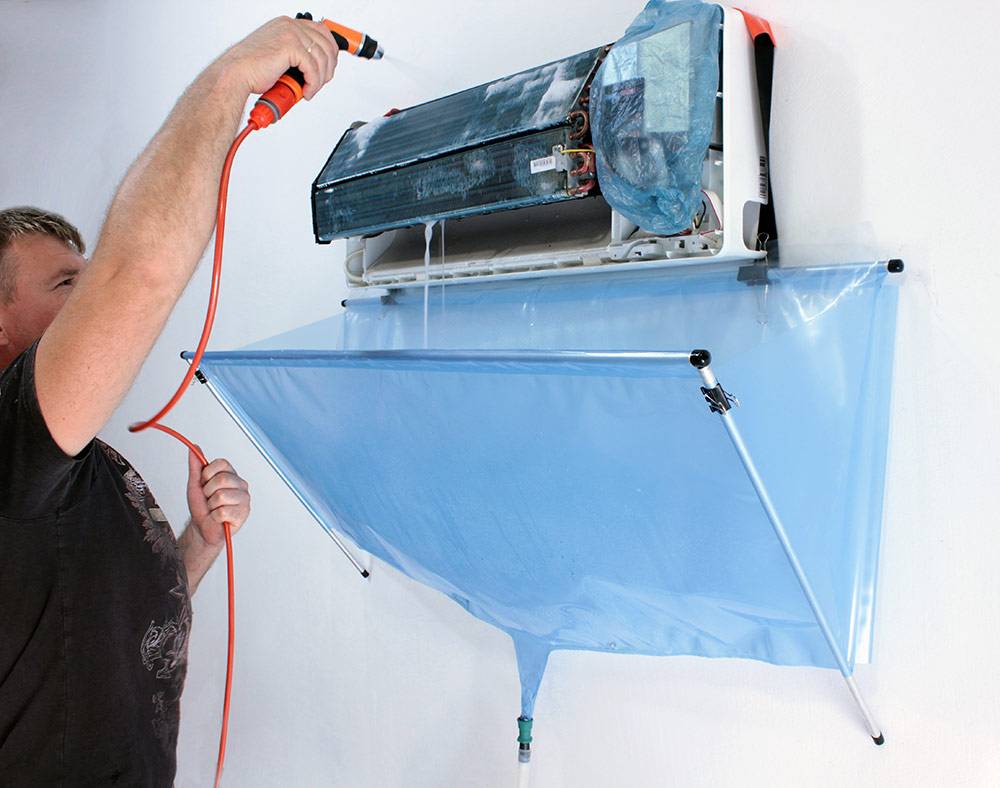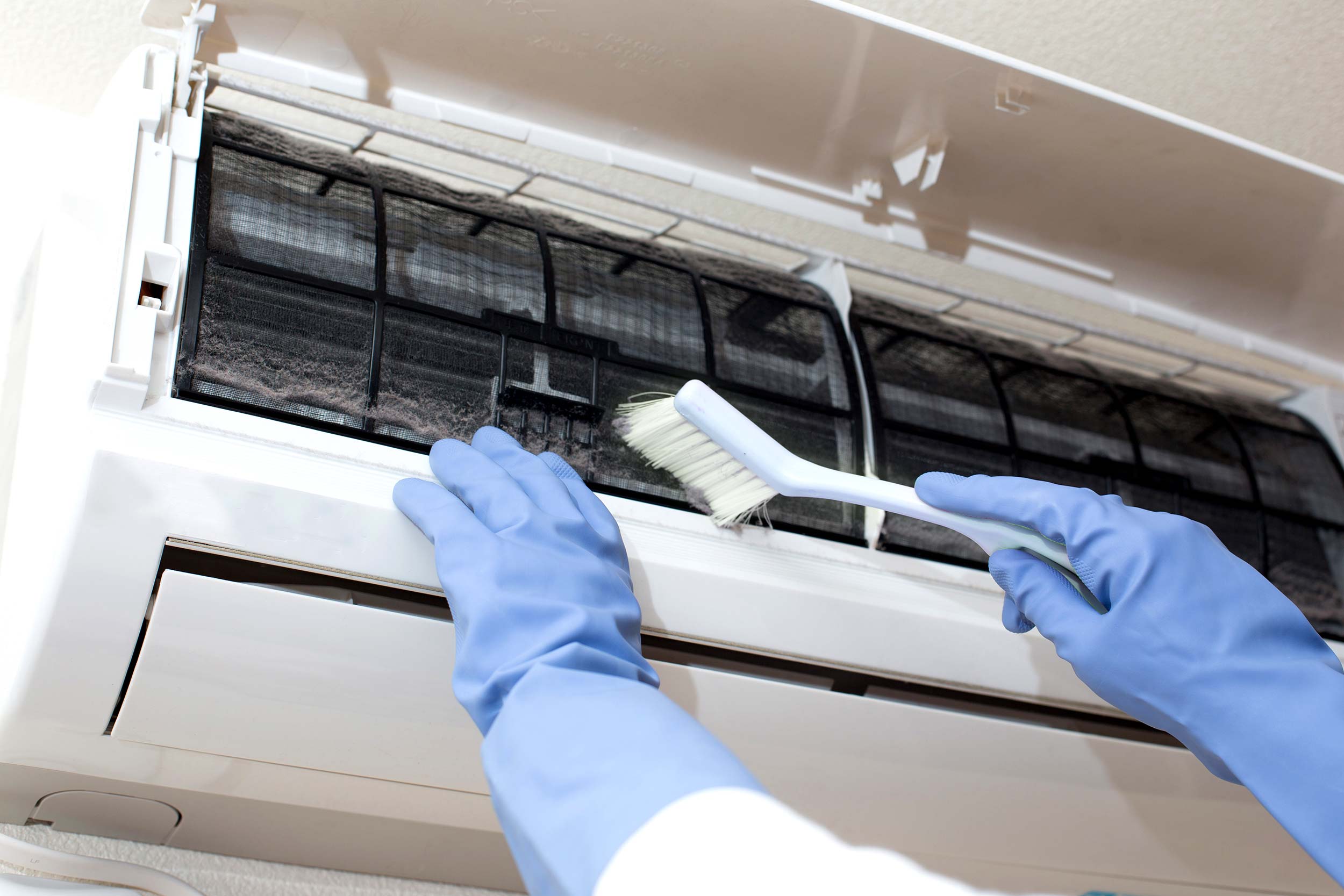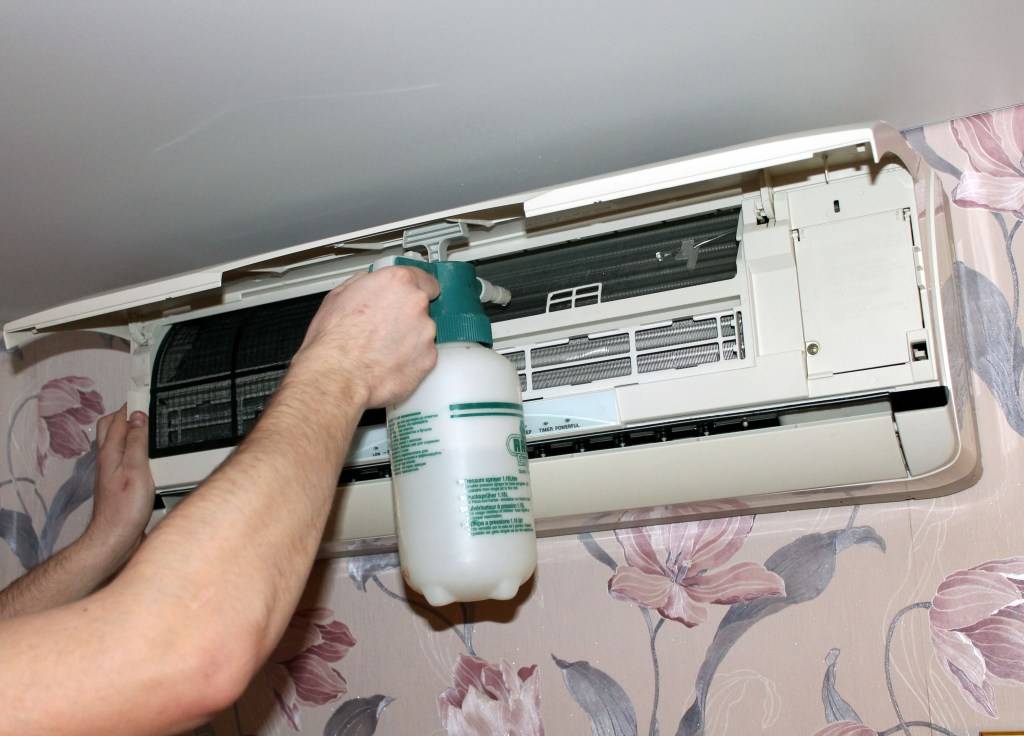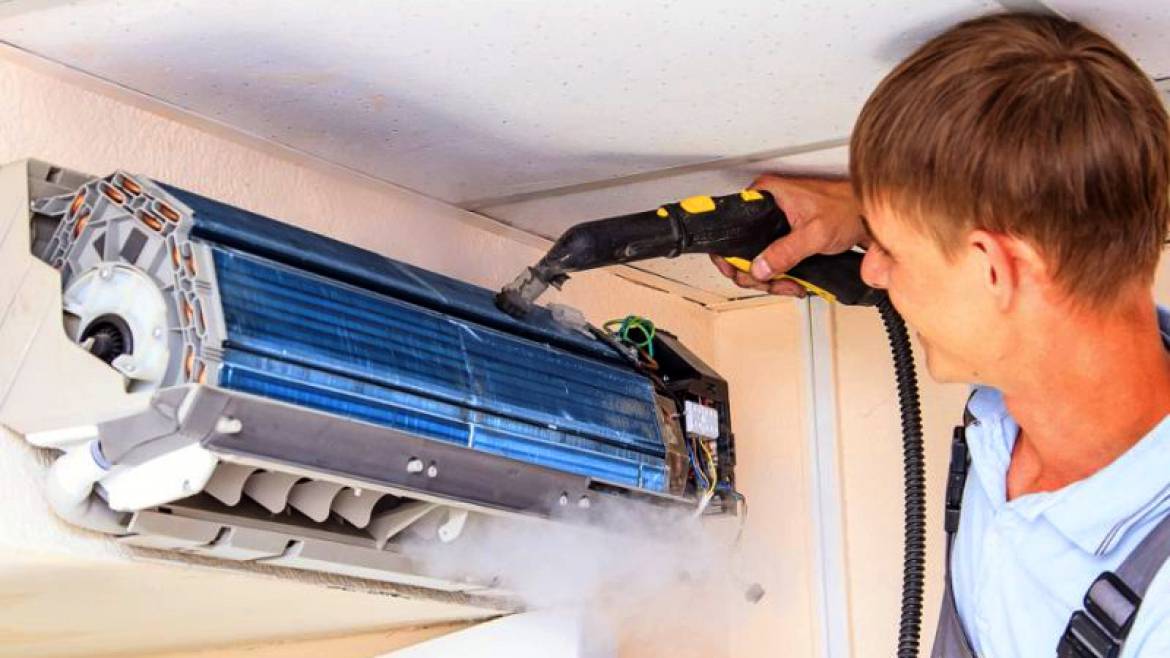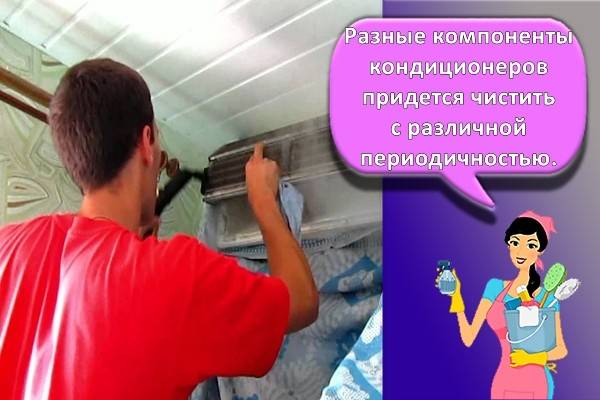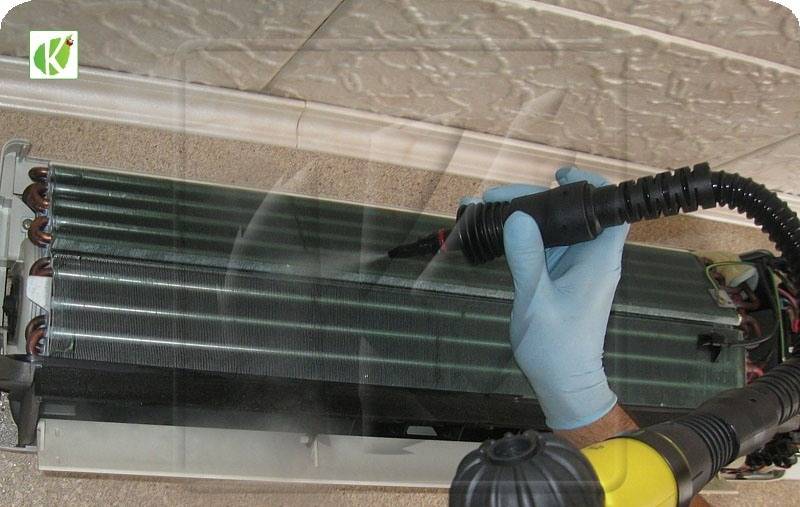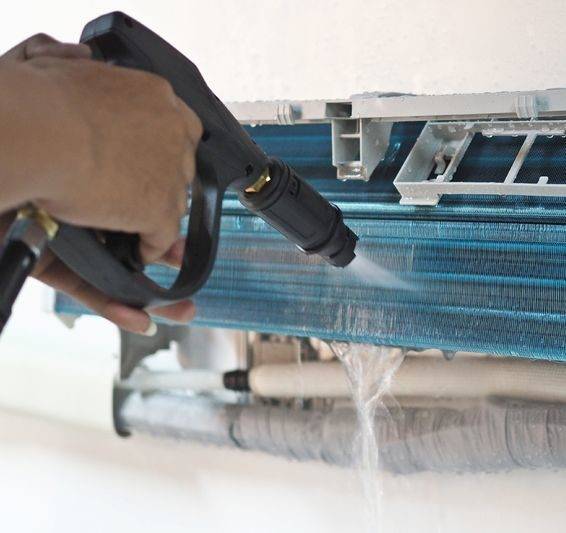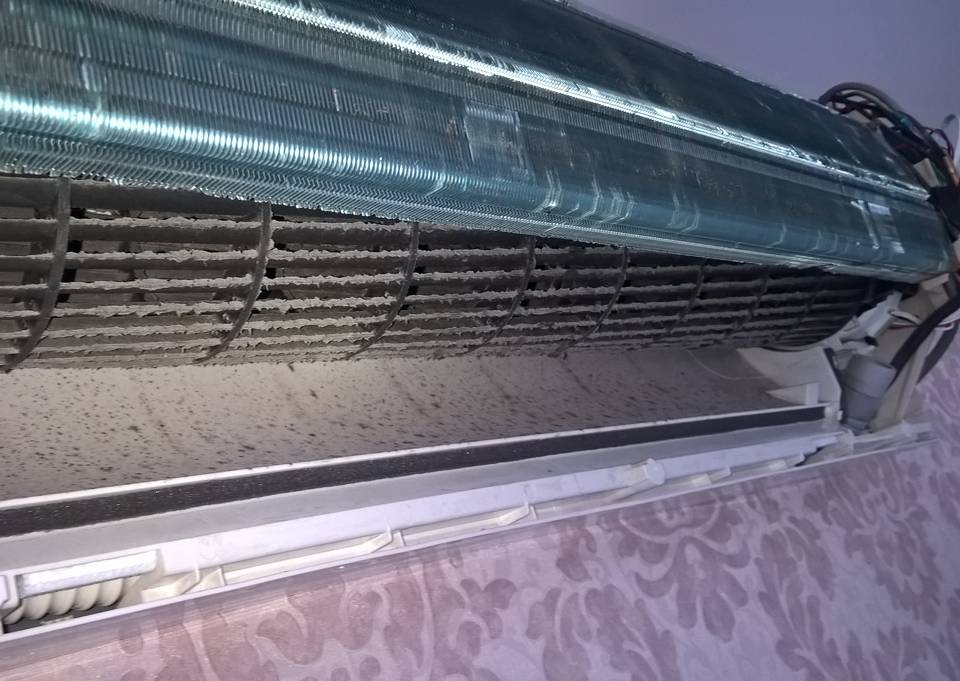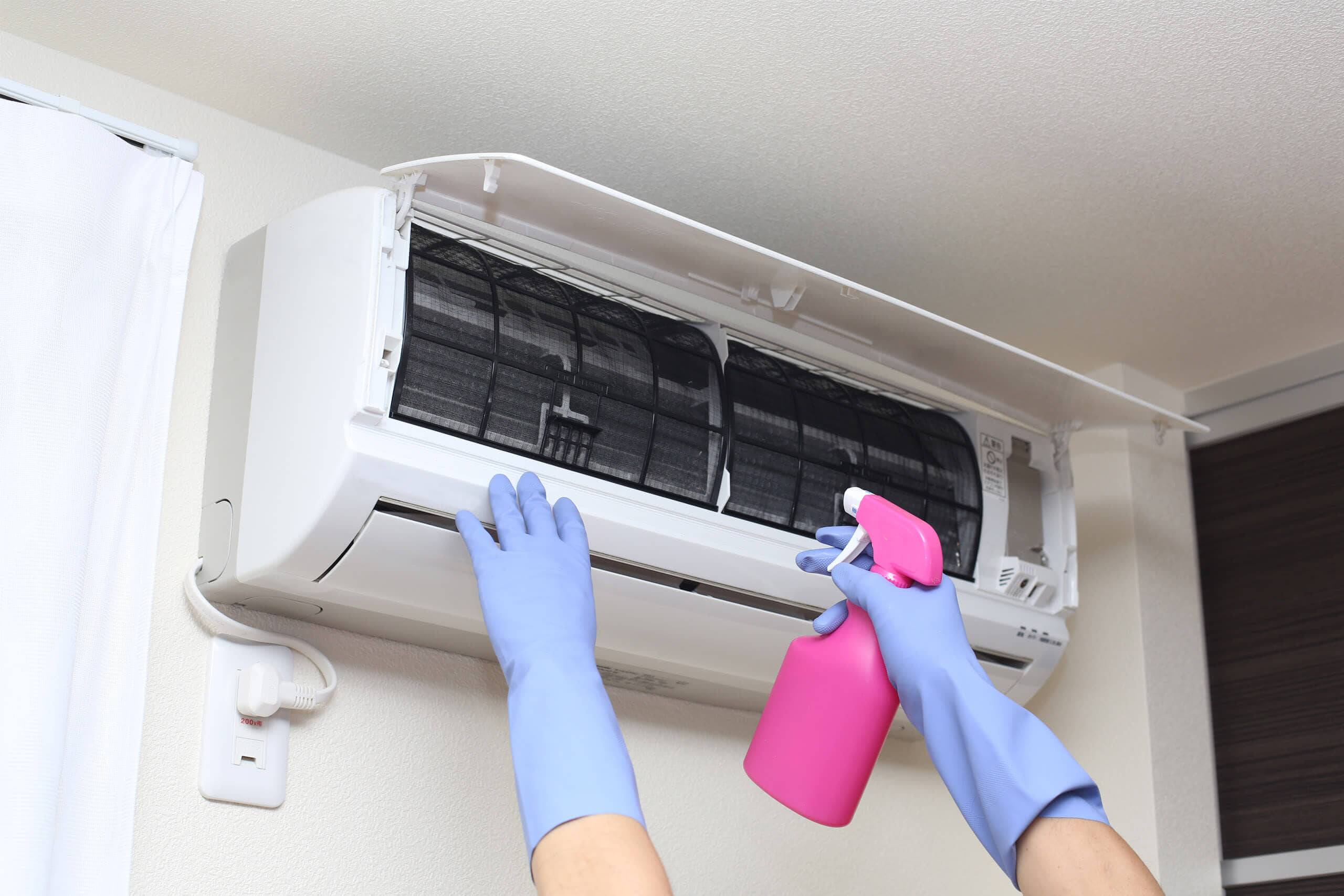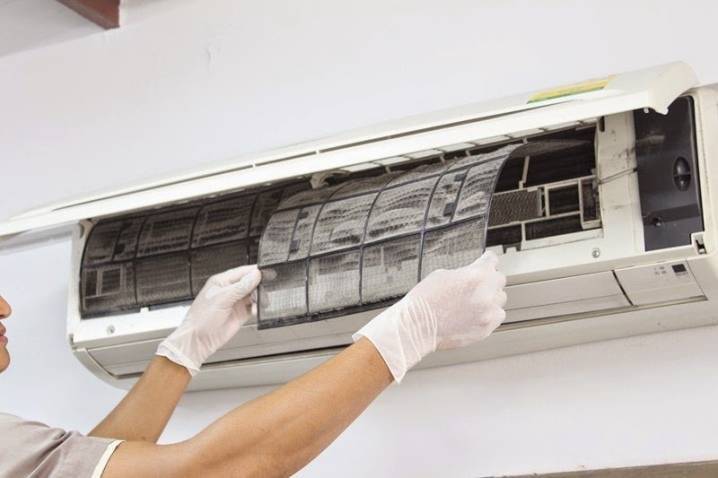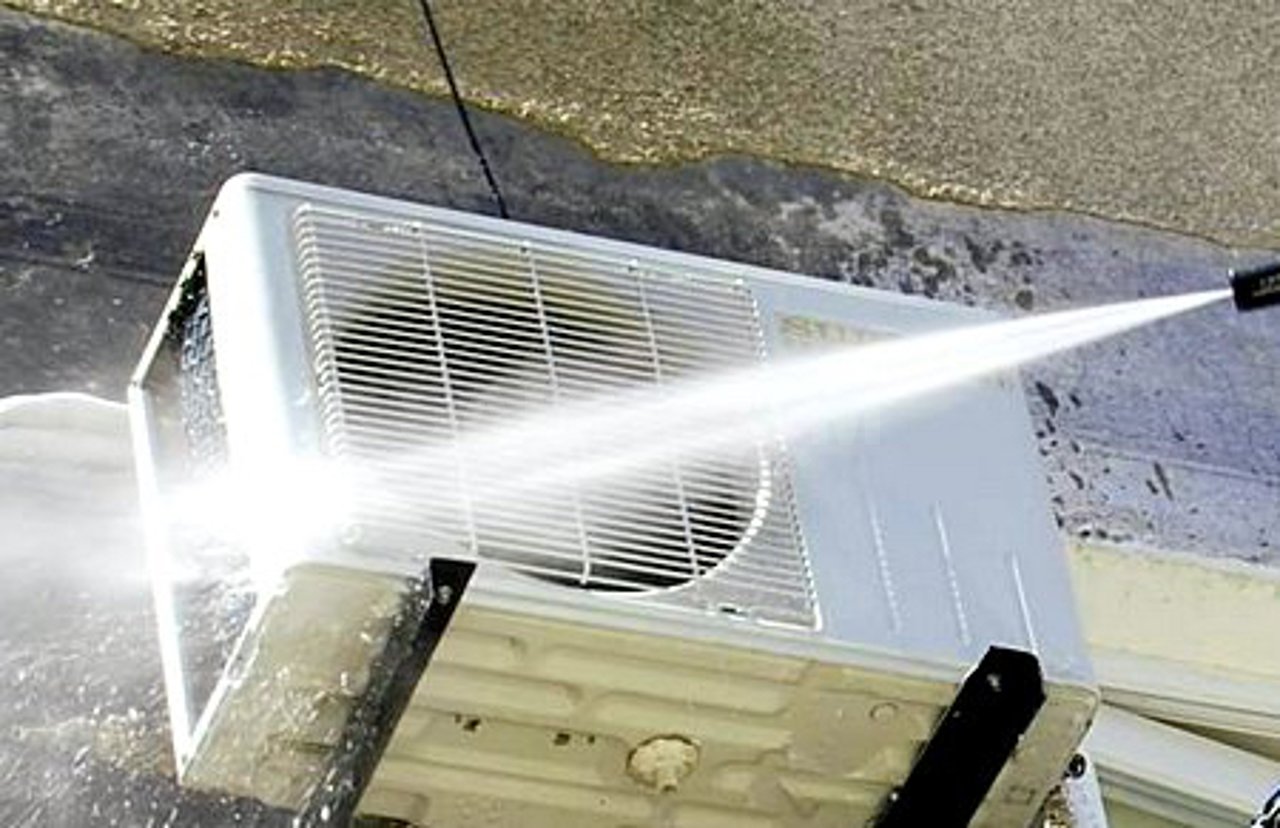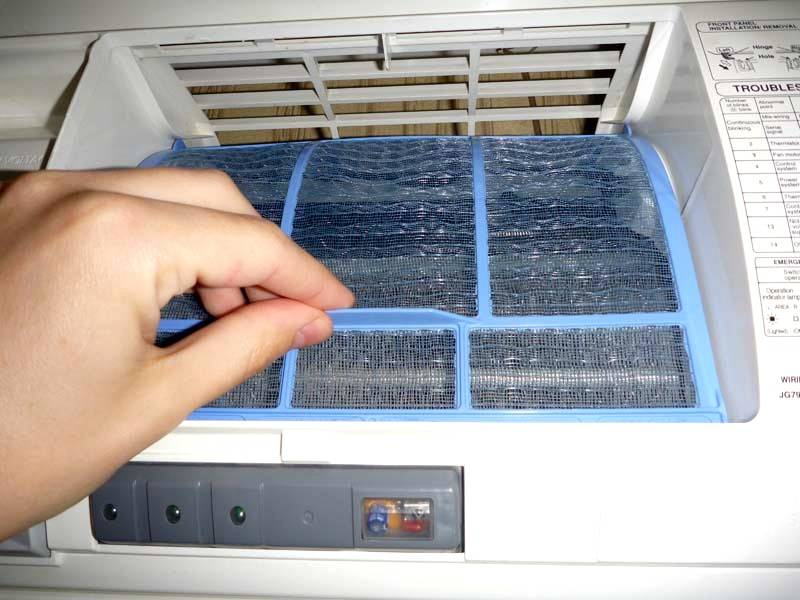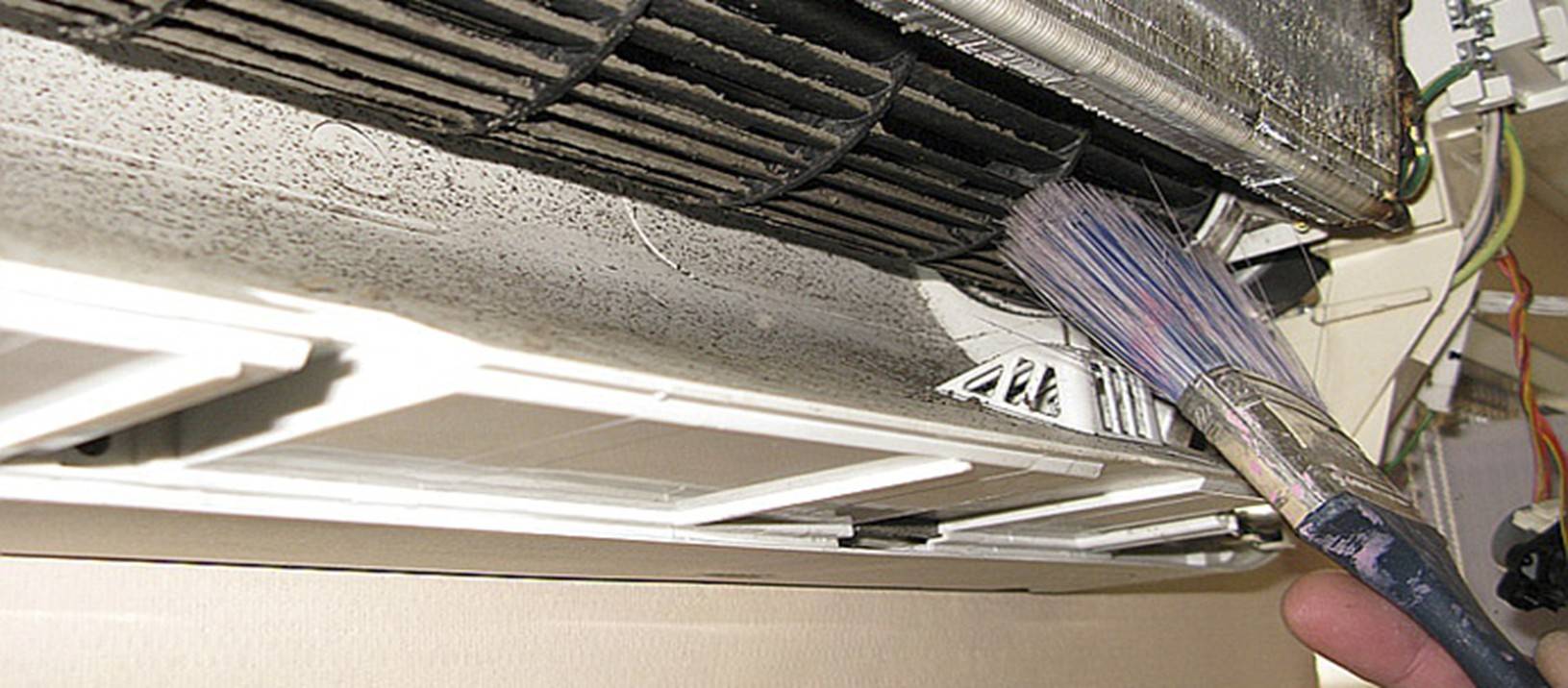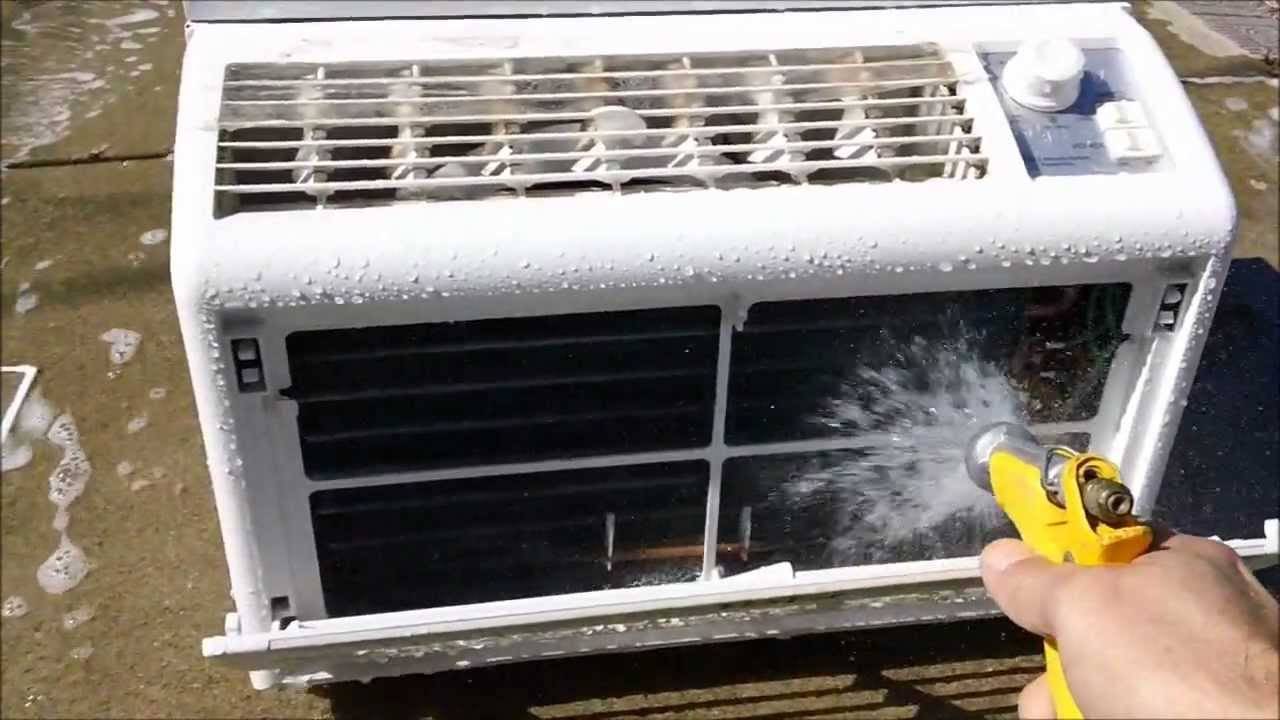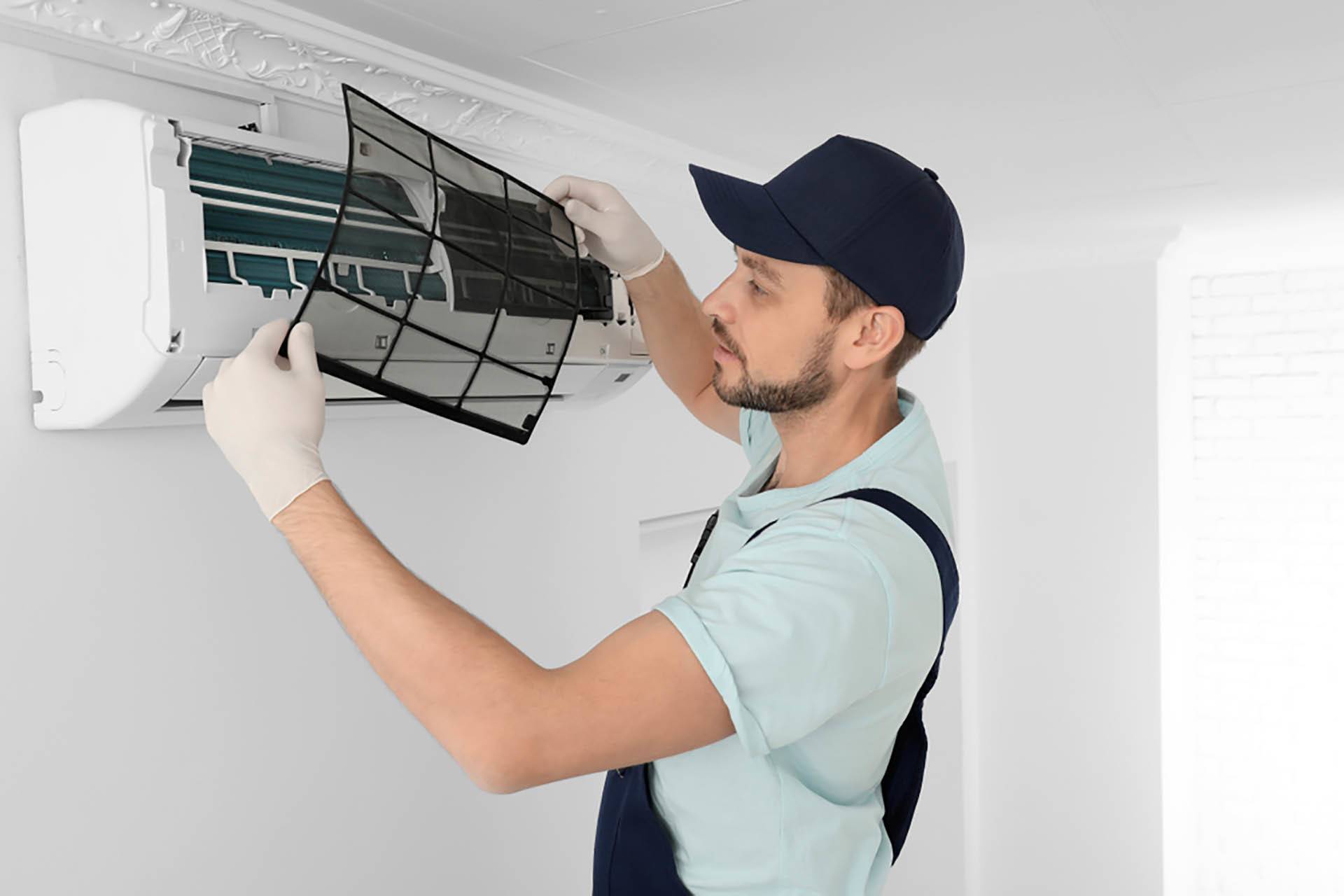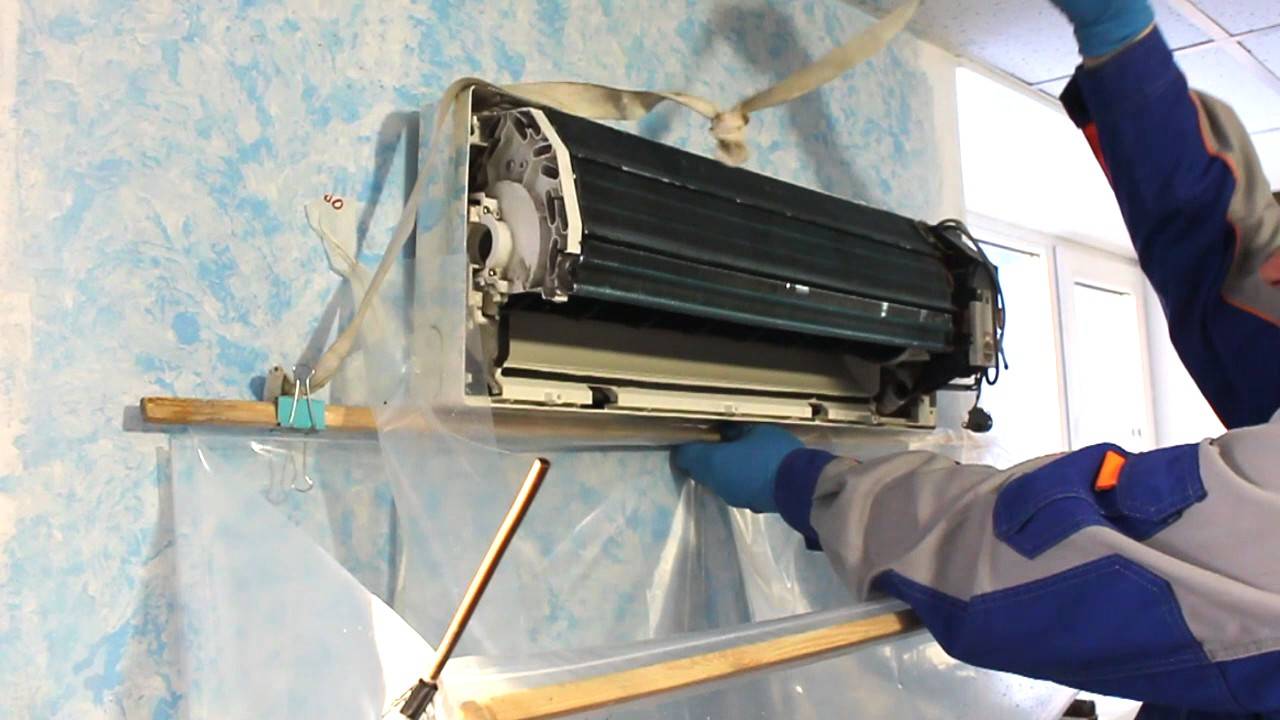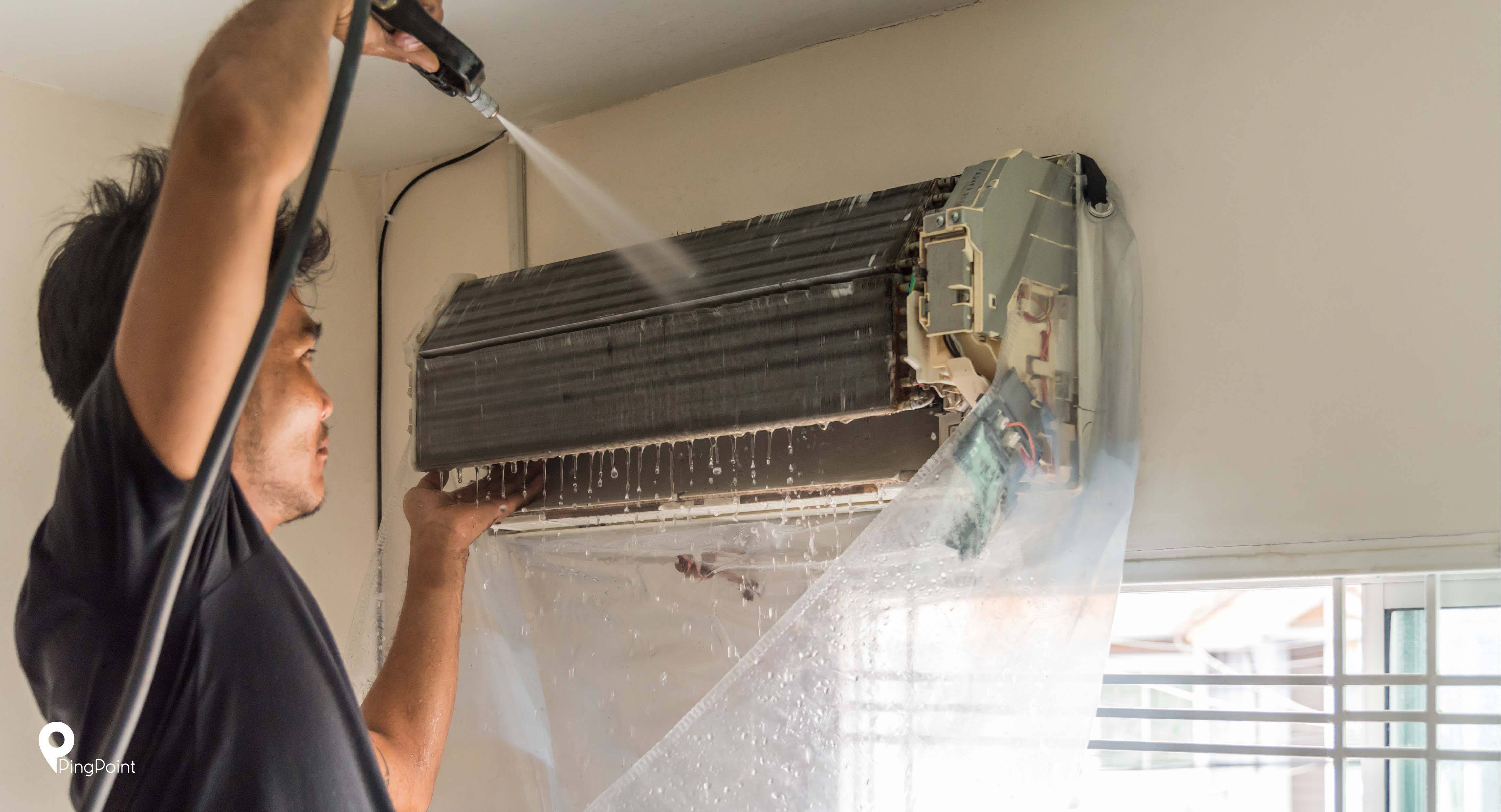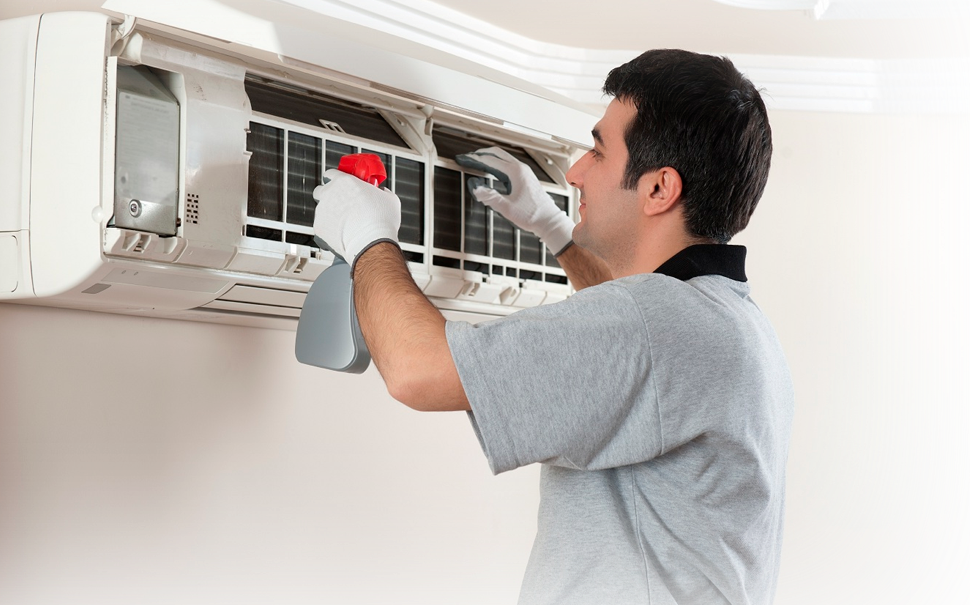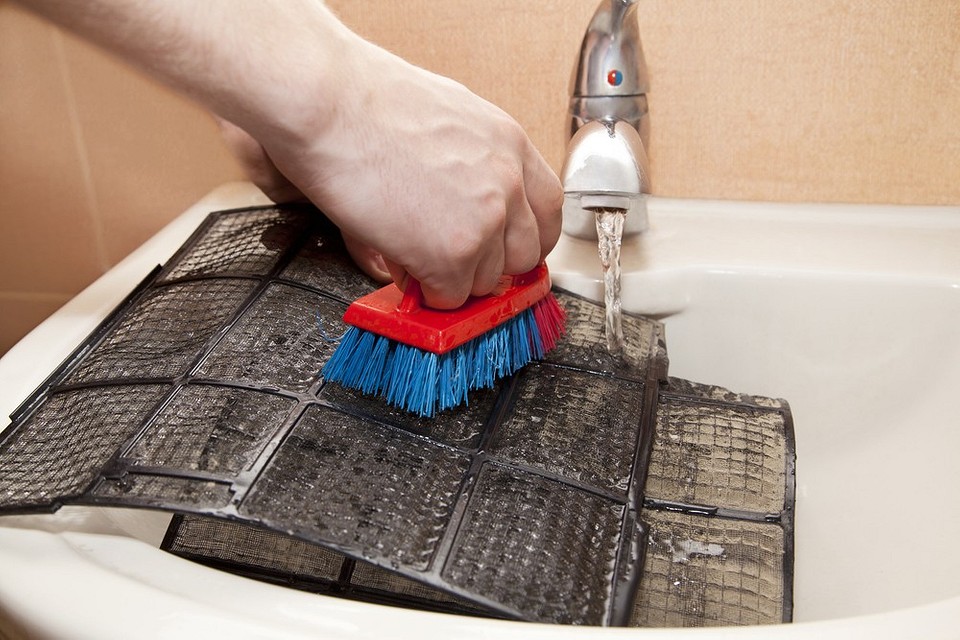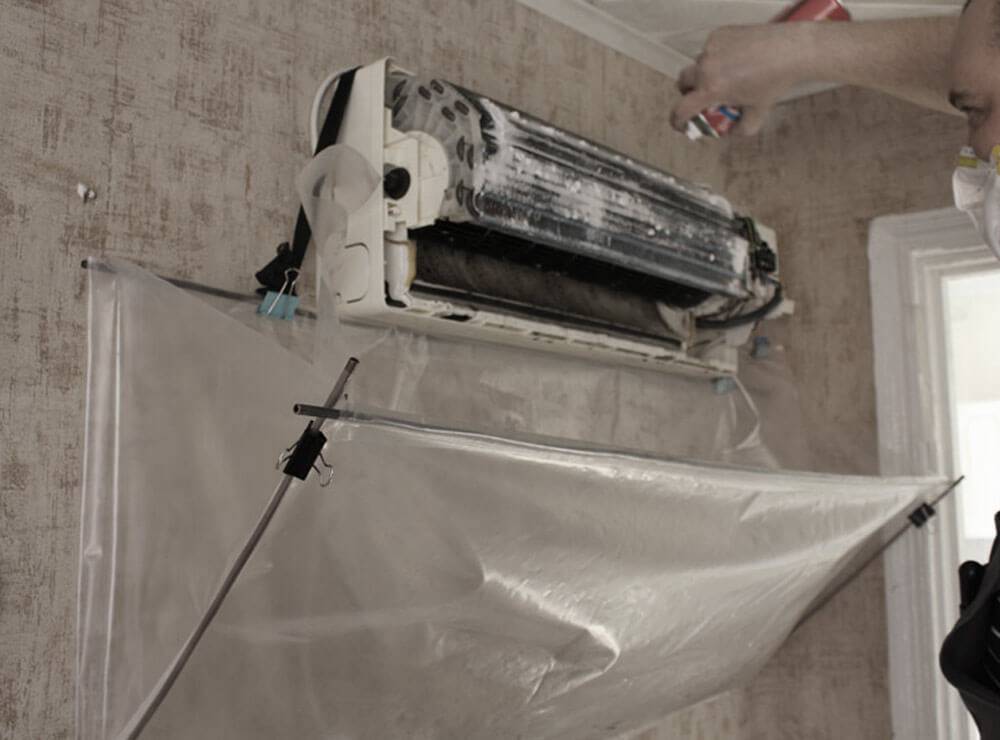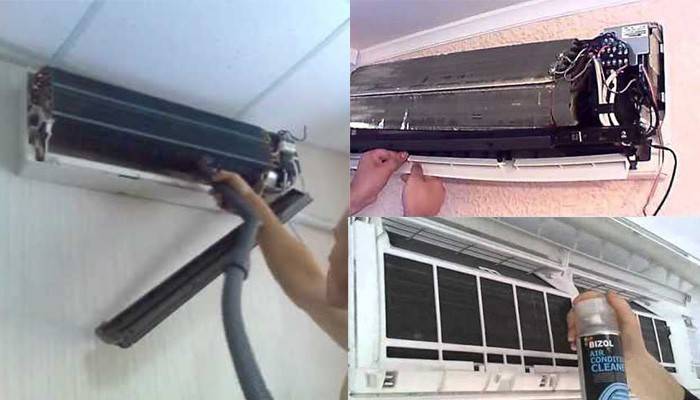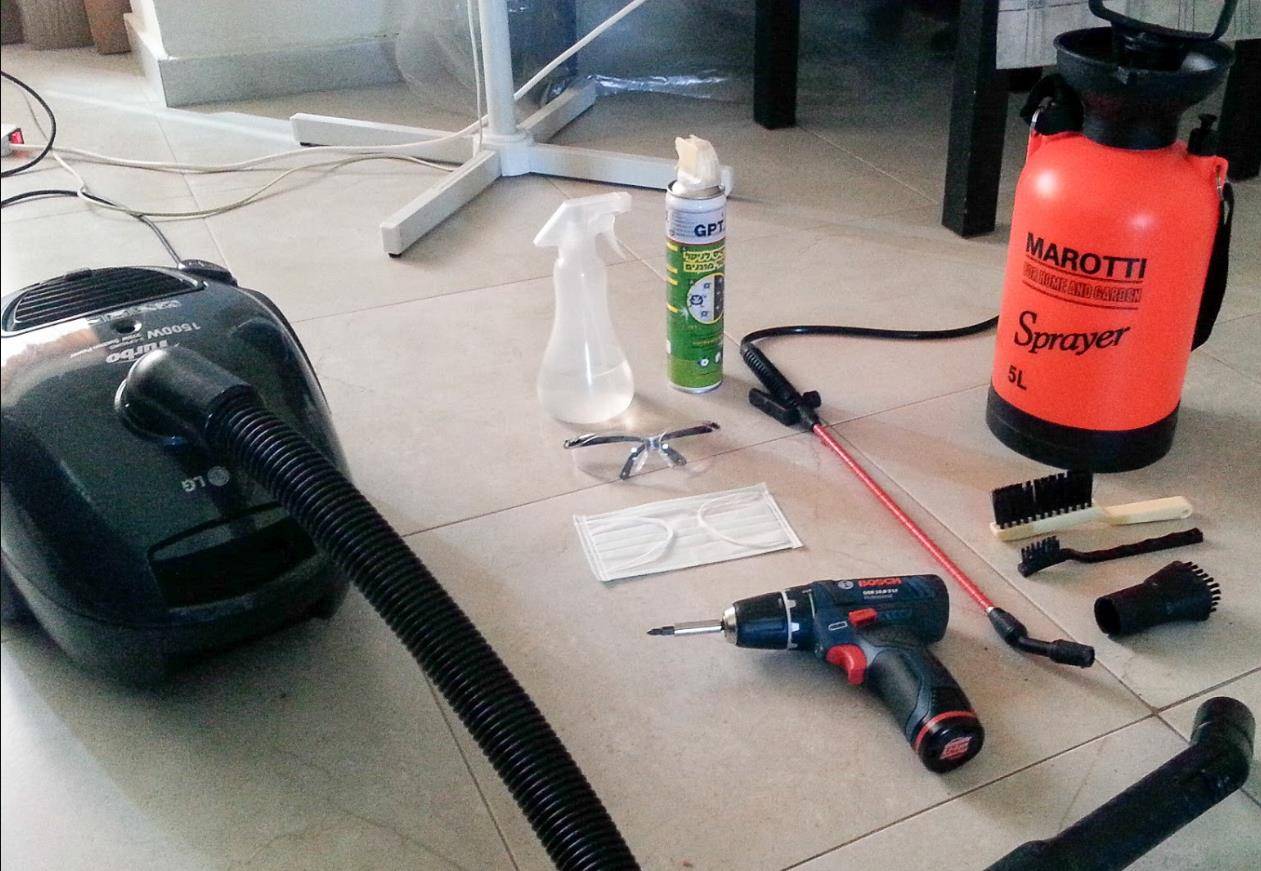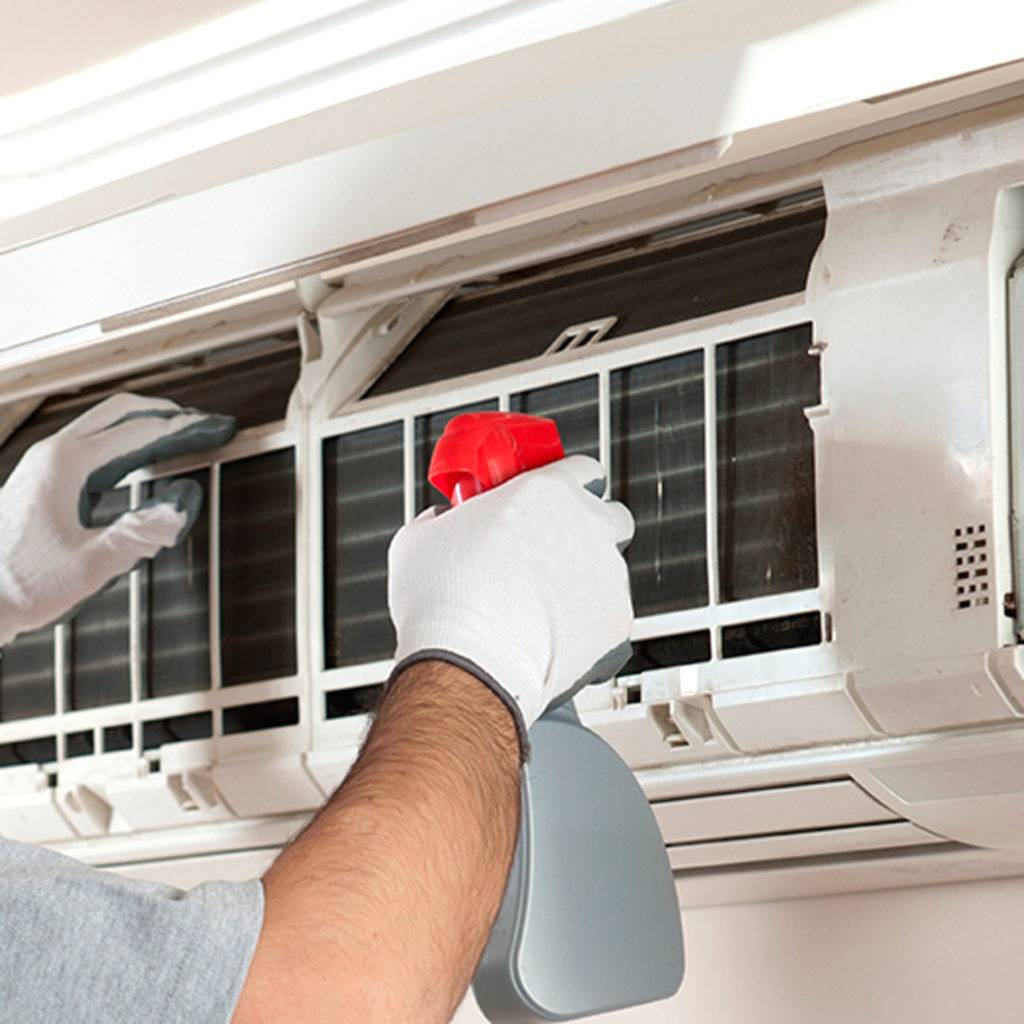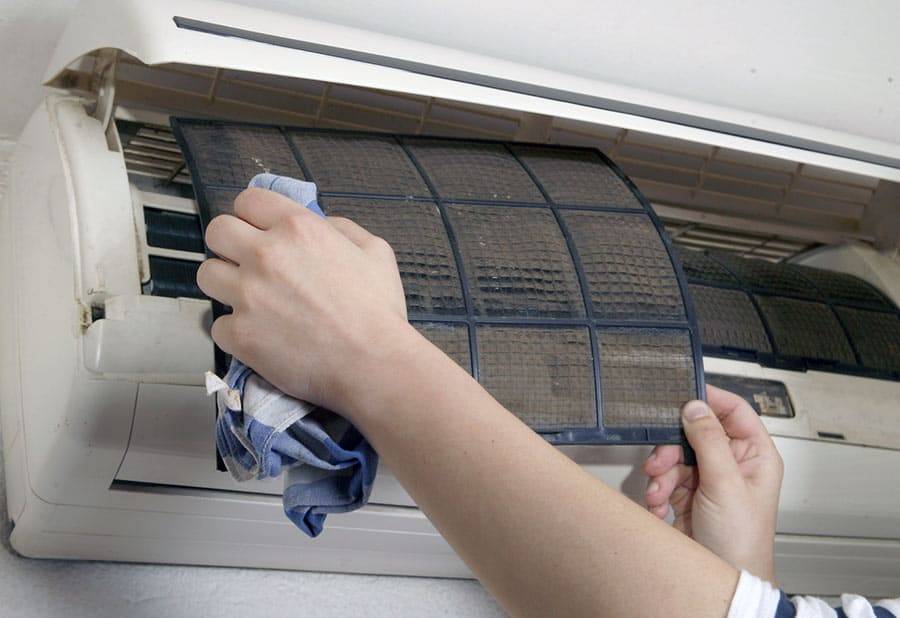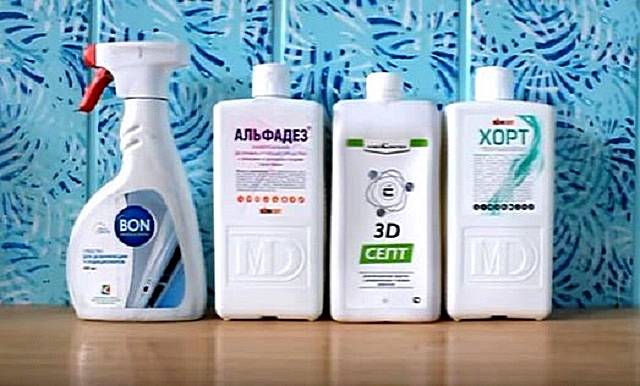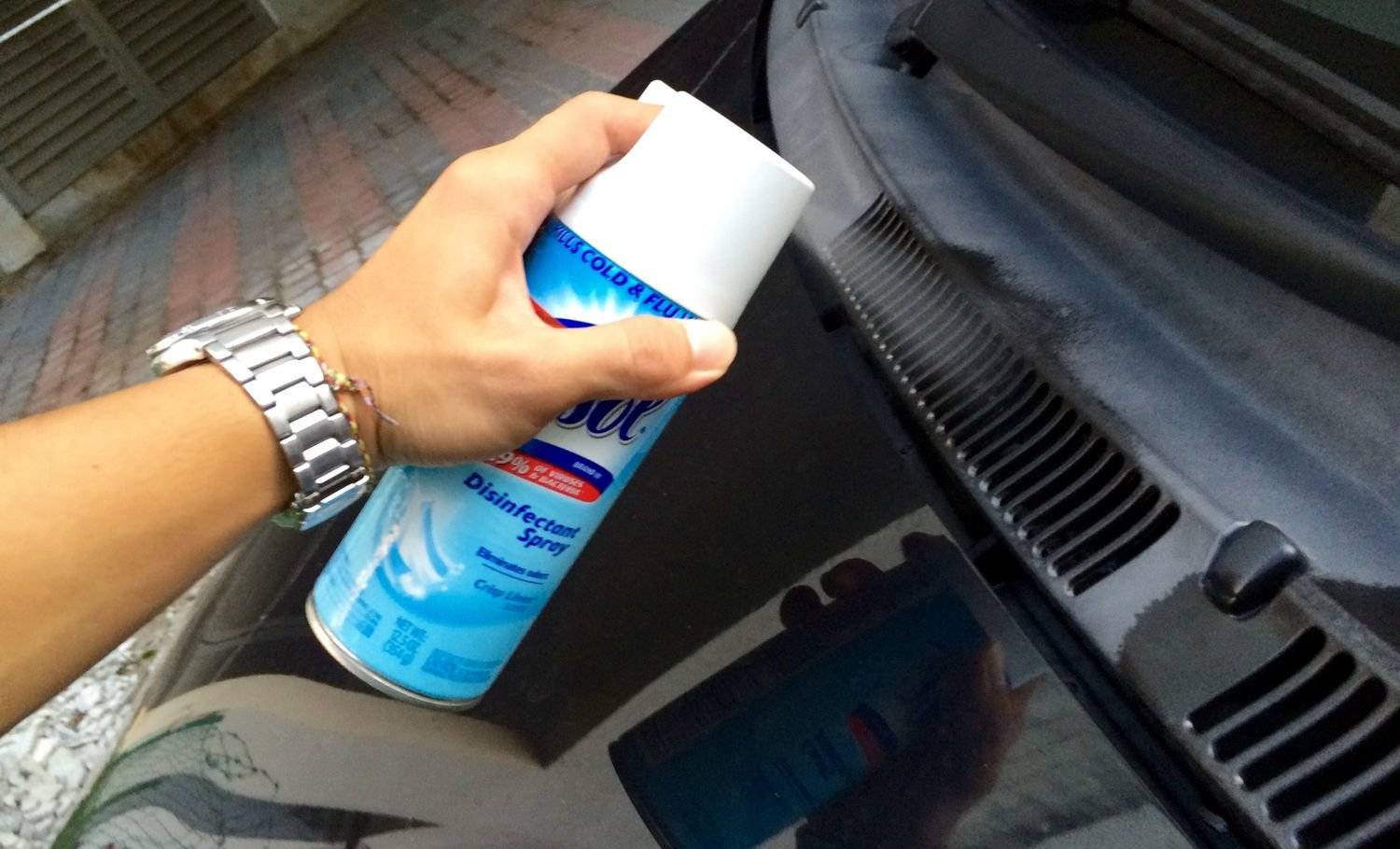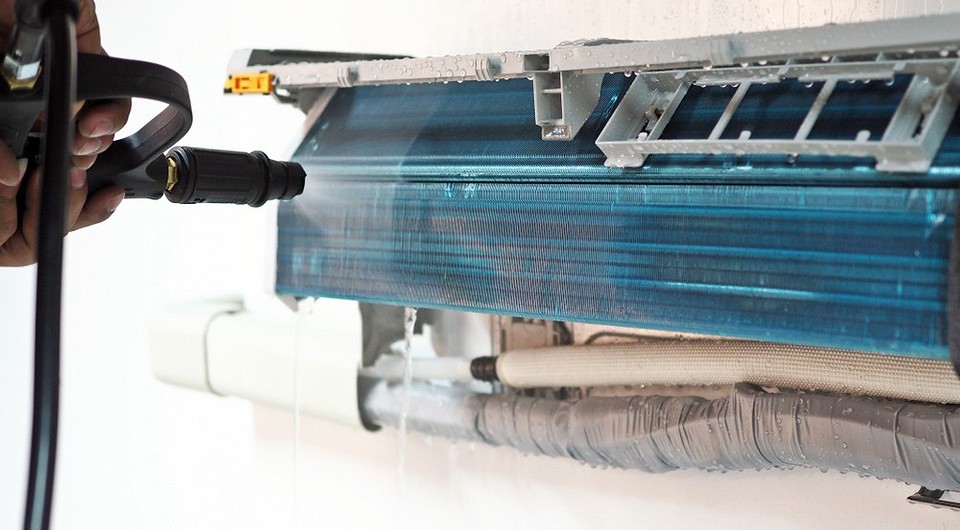Cleaning and disinfection of the drainage system
The drainage system in the air conditioner is a system consisting of two elements - a sump that collects water; liquid outlet tube. Dust in combination with moisture leads to the development of fungi and other harmful microorganisms. Because of this, unpleasant odors and other consequences appear.
The pallet is first disconnected from the board and the outlet tube. After that, the part can be easily rinsed under running warm water. A compressor or vacuum cleaner is used to clean the drain pipes. For the canal, use ordinary soapy water with a soapy solution or a neutral detergent. They are suitable for anyone interested in how to clean a split system.
Mold or mildew must be removed from the system if there are similar negative effects. Then the surface is treated with antiseptic agents, of any kind. It will not be superfluous to periodically process the pallet, because mold often accumulates inside this part.
Air conditioner cleaning tips
- Clean the filters in a timely manner, so you can avoid many problems with the device, including the rapid contamination of other parts of its indoor unit. Also wash other parts of the appliance annually. Remember, cleaning together with a careful attitude is the best prevention of air conditioners.
- Before cleaning the device, be sure to disconnect it from the mains.
- From time to time (usually twice a year) it is worth disinfecting the indoor unit, it will also be useful if the air blown out by the device begins to smell unpleasant. To do this, you can use special agents for air conditioners, a regular pharmacy antiseptic, or any disinfectant solution that contains alcohol. You will need about half a liter of the product. Disinfection should be carried out with the filter removed. Open the lid of the device, set it to the minimum temperature and maximum blowdown, then simply spray the product in the area where the air is sucked in. Do this until the solution starts to drain. For about ten minutes an unpleasant smell may come from the air conditioner, then it will disappear. Finally, remove any residual agent from the tubes and body.
- Do not scrub the heatsink with a sponge or brush, or try to wipe it dry with a cloth, as you may damage the thin fins.
- Entrust the first cleaning to specialists, while carefully monitoring their work. After that, it will be much easier for you to clean your home air conditioner yourself.
What parts of the air conditioner need cleaning?
What kind of cleaning does the air conditioning system require? Is it possible to cope with this task on your own or do you need to contact professional specialists?
The split system is most often cleaned. It is necessary to clean special removable filters that you can clean with your own hands. It will not take a lot of time, and most importantly, the owner of the device can carry out cleaning at any free time. It is better to carry out the first cleaning of the filters under the supervision of a professional and gain certain skills.
Let's take a look at some of the misconceptions about washing your air conditioner:
- Some air conditioner owners have the opinion that filter cleaning is a job that should only be done by service workers. Let's dispel these opinions: the process of cleaning filters is a completely ordinary user operation that does not require qualifications, and therefore it can be done on your own. It is better to clean the filters as often as possible and for this it is not necessary to arrange and pay for a call to specialists.As for the professionals? They have a completely different task of cleaning the air conditioning system.
- There is also a misconception about the location of the filters. Some owners of air conditioning devices assume that the filters are located in the outdoor unit and they are necessary to clean the air coming from the street. There is a type of window and channel type devices, they carry out a partial intake of air from the street for mixing. Such devices have filters that are washed with a certain regularity. However, the split - the system of columnar, floor-standing and floor-ceiling products is equipped with filters for air purification. They are installed in the housing of the indoor unit. They are easy to remove, allowing you to clean the air conditioner yourself.
- Probably the biggest misconception of people is that the owner does not need to open the box of the device at all and, moreover, there is no need for constant cleaning of the system parts. Someone thinks that it is enough to clean the equipment once every 3 - 5 years and for this it is necessary to call a team of specialists who will do this work. But the filters clog up very quickly, so to avoid damage to the device and to preserve your health, cleaning should be done much more often.
Step-by-step instructions for cleaning the indoor unit
In order to clean the indoor unit of the air conditioner you will need:
- Vacuum cleaner;
- A basin of water;
- Dish detergent;
- A container with clean water;
- Soft rags (preferably lint-free);
- Toothbrush (or any other);
- Soft brush (painting is suitable);
- Crosshead screwdriver;
- Thin rope, wire or easily bendable wire (40-50 cm).
We disassemble the indoor unit
Be sure to disconnect the air conditioner from the mains! Open the indoor unit of the air conditioner. To do this, click on the plastic clips that are on its side walls (see photo). Take out the mesh filter.
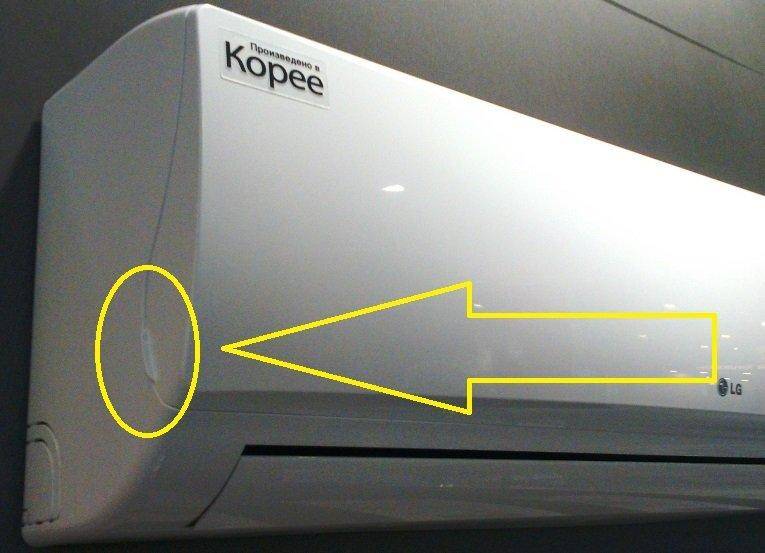
Indoor unit cover latches.
After that, unscrew the screws that secure the air conditioner case to its inner part and remove it. In some models, you need to pull it up to do this, but mostly it will feed itself.
Important!
The power supply cable and wires are connected to the display on the case. To avoid breaking them, tie the case to the inside of the air conditioner with rope or wire.
Cleaning the filter
- Thoroughly rinse the filter of the indoor unit of the air conditioner with running water to wash off the main dust and dirt.
- Then dilute the detergent in a bowl and put the filter in it. It should "sour" for 20-30 minutes to finally be cleansed of impurities.
- Rinse it again with running water.
- Leave the filter to dry - it must not be installed wet in the air conditioner.
Cleaning the radiator
Vacuum the radiator without the nozzle first. At the same time, be careful - the vacuum cleaner pipe should not touch the plates so as not to damage them. After that, go between the plates with a soft brush to remove any remaining dirt.
Dilute the detergent in water to form a concentrated solution. Apply it to the radiator with a soft brush. By the way, if there is no particularly strong pollution, you can use oxygen bleach. Use the same brush to thoroughly clean the radiator of the indoor unit.
Sometimes (especially if the air conditioner is in the kitchen), grease mixed with dust settles on the radiator. It forms a kind of plugs and is a breeding ground for microorganisms. They need to be removed with a thin knife, and then rinse off the remaining dirt.
After the radiator is cleaned, rinse it with clean water using a soft brush. Blot any remaining water with a dry cloth.
Advice
If you accidentally bend the radiator fins, it’s not a problem. They can be leveled with a regular knife.
Cleaning the fan
There is a fan under the radiator. It looks like a cylinder with blades (see photo).In most cases, you cannot remove it (and if you can, then a layman will definitely damage something). Therefore, the entire procedure will have to be performed “on the spot”.
Use a brush to brush the detergent / water solution (which we prepared earlier) onto the fan blades. Try to get to the inside of the blades to rinse it as thoroughly as possible. Rotate the fan cylinder to clean all blades. You can wash off the remaining dirt with the same brush.
Advice
In some models of split systems, the distance between the fan blades is too small and you cannot get close to its inner part. In this case, apply the detergent solution with a spray bottle. Use it to wash off the dirt with clean water.

Air conditioner indoor unit fan.
Necessary cleaning agents and tools
Cleaners and disinfectants for air conditioners
Most household air conditioner cleaners are available on the market in the form of foam cans or aerosols.
Foam is usually used to clean the heat exchanger itself. After shaking it, it is necessary to evenly apply it to the entire area of the heat exchanger, after which it turns into a liquid, washing away the impurities. Detailed instructions should be included with the product upon purchase. Sprays are applied to the heat exchanger and to the intake deflector.
A list of the most popular brands of cleaning agents with their characteristics is presented below in the form of a table.
| Brand name | Main characteristics | average price |
| EasyClean | Feature - selective action, chemistry removes pollution without affecting other materials. Effective against dust, grease stains, removes harmful bacteria.
Release form: aerosol 500 mg. |
About 1000 rubles. |
| RTU | According to reviews, this spray is really effective in removing almost all types of contamination from heat exchangers. Antimicrobial treatment is also present.
Release form: 1 liter nebulizer. |
About 2,000 rubles. |
| DOMO | It is a foamy, highly effective cleaning agent for evaporative and condenser heat exchangers in domestic and automobile air conditioners. | About 450 rubles. |
Instruments
For self-cleaning, you will need the following tools:
- screwdrivers (flat and Phillips);
- personal protective equipment - rubber gloves, glasses;
- a special package with a drain for water, which can be purchased at a specialized HVAC store;
- a spray bottle to rinse off the cleaning agent;
- beforehand, you can use a vacuum cleaner to extract dust and cobwebs from hard-to-reach places.
Service package for cleaning the air conditioner

A service package is a special package made of polyethylene or other materials, sold in HVAC stores, costs an average of 1000-1500 rubles. It is designed specifically for cleaning air conditioners, covering the entire space under the air conditioner, so that when cleaning, all impurities can get there, and you don't have to worry about dirtying the walls.
Can I clean with a steam generator
When cleaning the air conditioner in addition, or as an alternative to cleaning with chemicals, a steam generator is often used. The properties of the steam generator allow you to safely remove a lot of dirt in hard-to-reach places, which is why it has gained a certain popularity. The appliance generates steam and dispenses it in a small jet.
But still, the disadvantage of this type of cleaning, in contrast to chemical cleaning, is the relatively high cost of the steam generator. Most often, this method is used by employees of specialized companies for cleaning houses and apartments.
We clean the air conditioner at home
Cleaning the filters will be a simple job, but, unfortunately, not only they are contaminated, but also other parts of the air conditioners.It is much more difficult to wash them, as for this, some types of devices even need to be disassembled, so if you are not confident in your abilities, it is better to entrust this to professionals. However, it is also possible to completely clean the air conditioner at home on your own. First, remove, wash and let the filters dry. In the meantime, get busy with other parts of the device.
Cleaning radiators
Heat exchanger radiators are responsible for heating and cooling the air. They consist of the thinnest plates, arranged very densely. If the gaps between them are clogged with dirt, this will lead to a deterioration in the performance of the final device. Slightly dirty radiators can be cleaned with a long bristle brush and a powerful vacuum cleaner
This must be done very carefully so as not to deform the radiator fins.

But dust trapped on the radiator fins can combine with condensation and turn into a mud film. Such pollution is sometimes able to close up all the gaps. Removing such dirt is very problematic. For this, as a rule, steam cleaners are used. Naturally, such work should be entrusted to specialists.
Cleaning the fan
The next part of the air conditioner, which often needs to be cleaned, is the rotary fan. Outwardly, it resembles a roller with many membranes. This detail drives the already cooled atmosphere into the room from the air conditioner. A lot of dust is also retained on it, which subsequently turns into dense mud deposits. Without cleaning, the fan membranes can become so dirty that the device simply cannot perform its functions.
How to clean the air conditioner in this case? This is not so difficult to do. To begin with, it is worth covering the wall with oilcloth on which the device is located and the floor under it. Next, it is necessary to thoroughly moisten all the partitions of the fan with soapy water and leave it for a while so that the dirt can get wet. After that, you need to turn on the air conditioner at minimum speed in order to drive the air through the fan. At the same time, particles of dirt and soap solution will "fly out" from the air conditioner. After a few minutes, turn off the device and finish cleaning the partitions by hand using a soap solution and a brush.

Cleaning the drainage system
The accumulation of dust, grease and even mold and mildew can litter the drainage system. As a result, the water will not flow outside, but inside the room. The most unpleasant thing is that the mold accumulated in the pipes may well spread first to the drain pan, and then to the radiator and the walls of the air conditioner.
There are several ways to clean the drain. At home, it's easier to just rinse it with detergents and water. For this, a dishwashing detergent is a good choice. After cleaning the drain, be sure to rinse the drain pan as well, as it often gets dirty as well.
Cleaning the outdoor unit
Perhaps, the external unit is the most difficult to clean, since it is often located in hard-to-reach places. Fortunately, you can clean it 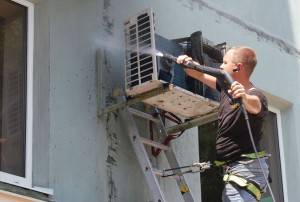 just once or twice a year.
just once or twice a year.
For high-quality cleaning, it is a good idea to remove the top cover from the outdoor unit. Next, you need to remove large debris from it. Then clean the unit with a vacuum cleaner (it must be powerful, only in this case you can remove dirt from the radiator and external filters) and a brush
After that, it is recommended to gently wipe the fan and the inside of the unit with a damp cloth.
Much more effective will allow you to draw the cleaning of the outdoor unit with a steam cleaner or compact mini-sinks. However, using them, keep in mind that the assembly and connection of the air conditioner can be made only after all the parts are dry.
Funds
All preparations for cleaning and disinfecting air conditioners can be divided into several groups:
- means for cleaning and disinfecting the indoor module and protecting the heat exchanger;
- cleaners for the external block of the system and protection of the heat exchanger;
- household chemicals for widespread use (used for processing internal elements, individual parts of the indoor and outdoor unit).
All of these varieties are used to disinfect products that may develop mold, fungus, and pathogenic bacteria. Also, such preparations provide good anti-corrosion protection of the structure and prevent the deposition of mineral salts.
Today there is a large selection of household cleaning products for split systems.
"Suprotek". This product is intended for cleaning split systems. It is able to quickly remove all odors and carry out a complete disinfection of equipment. Also, this substance can significantly freshen the air, since it contains a large amount of eucalyptus essential oils, which fill the air with a pleasant aroma. Most often "Suprotek" is used for the indoor unit.
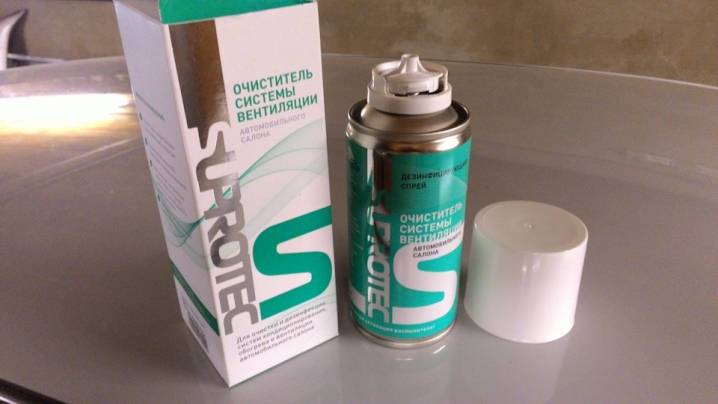

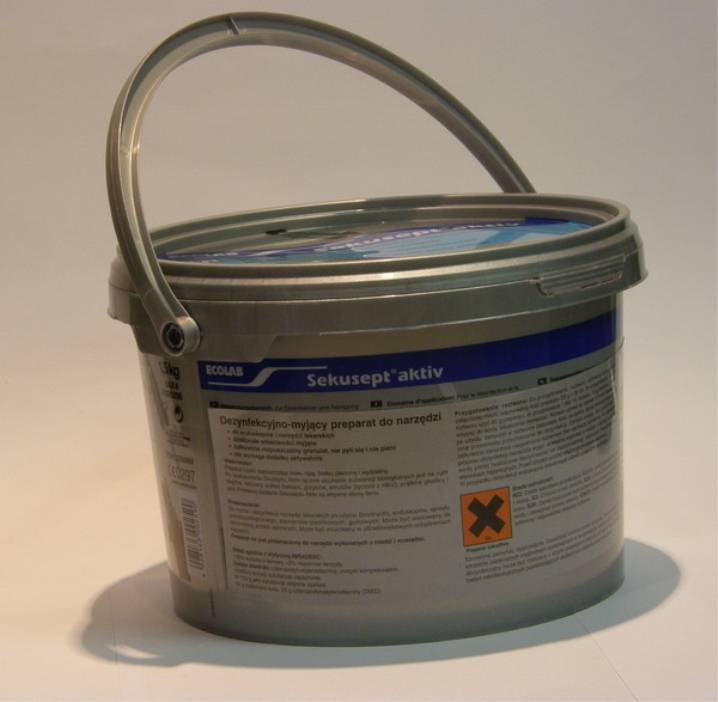
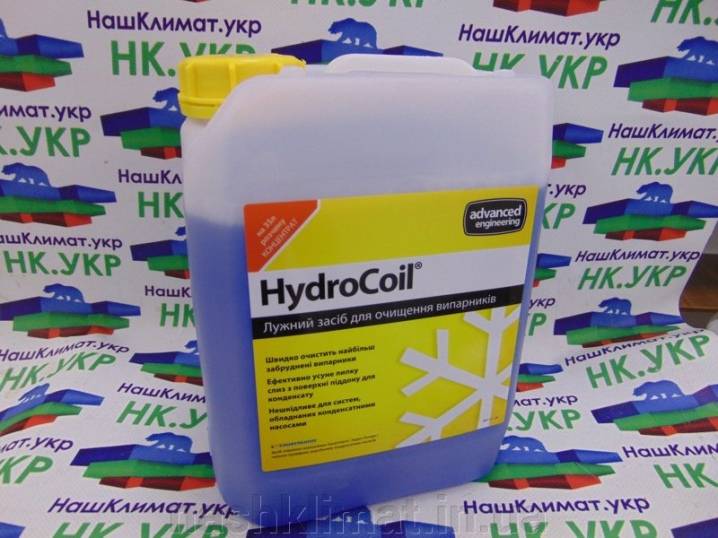

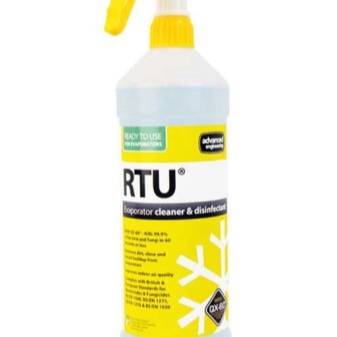

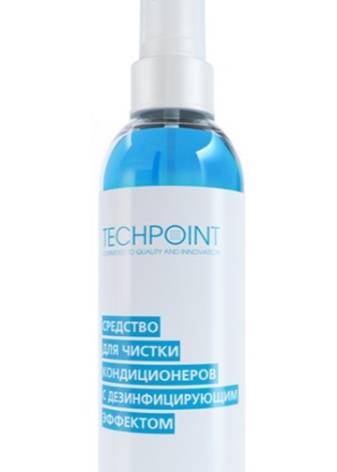
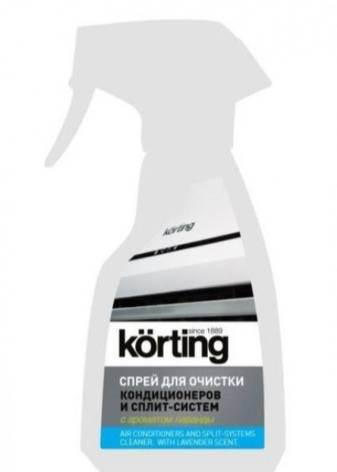


1 Choosing a disinfectant
There is a large selection of different disinfectants for air conditioners on the market today. All funds are intended for the maintenance of domestic or automotive split systems. It can be:
- foam products in cans;
- air conditioner disinfectants based on alkali, which are sold in plastic bottles and cans;
- often, home craftsmen use various medical antiseptics for the air conditioner as a savings, for example, chlorhexidine.
It should be clearly understood that disinfection of the air conditioner in the house or in the car is a mandatory preventive measure. Maintenance includes incomplete disassembly and minor contamination of the device. This leads to a number of recommendations regarding the choice of a disinfectant:
- If the fan impeller or evaporator has a large layer of dirt, then before disinfection it is necessary to clean all the elements with a strong detergent like Carlyclean, Top House, Cond Cleaner.
- The best cleaning method is a penetrating foam solution in an aerosol bottle. According to the manufacturers, after cleaning, the composition leaves an antibacterial protective film on the heat exchanger, which lasts 2-3 months.
- It is possible to clean air conditioners with medical antiseptic solutions, but this is not very convenient. Unlike foam, the antiseptic does not sufficiently penetrate into hard-to-reach areas. Moreover, this is a significant disadvantage during the cleaning of the car cooler.
Foam aerosols can disinfect air conditioners equally well both in apartments and in cars. There is only one condition: to disinfect the cooler in a car, you need to purchase a special flexible elongated nozzle that is put on the cylinder (as a rule, it is included in the kit).
2 Cleaning instructions
Regardless of the design features and the type of air conditioner, any antibacterial cleaning is carried out in the same order all the time. The main stages of the work are as follows:
- 1. First, disconnect the cooling device from the mains. In the car, it is enough to turn off the engine and turn off the ignition.
- 2. Then you need to remove the cover of the indoor unit and take out the filters. In the car, you need to pull out the element that filters the air in the cabin.
- 3. Now you need to shake the can thoroughly, apply liberally to the fins of the evaporator and, if possible, to the fan impeller. There is no need to save money and leave part of the product "in reserve", one bottle is designed for one cleaning.
- 4. Next, you need to wait about half an hour (the exact time is indicated on the packaging of the cleaning agent).
- 5. Switch on the equipment for ventilation at maximum fan speed. If the manufacturer of the composition indicates in the annotation, then it may be necessary to switch the split system to cooling or heating mode.
- 6.The removed filters must be thoroughly washed with a soft brush and detergent. When the filters are dry, put them back and close the lid.
- 7. After processing and turning on the air conditioner, the foam will drain into the pan and go out into the street through the drainage system.
In the above instructions, there is no important stage in the work - incomplete disassembly of the air conditioner. Disassembly must be considered separately for each type of refrigeration equipment.
What to do if there is mold in the air conditioner
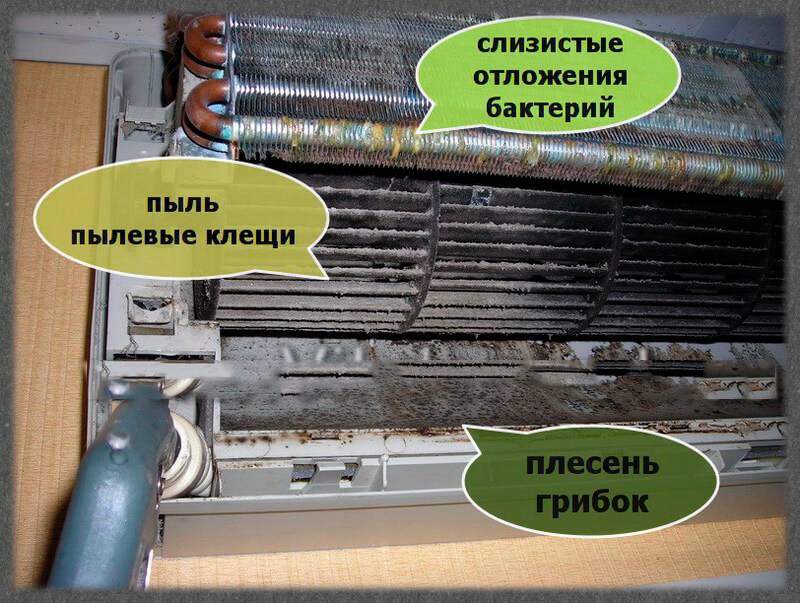
The formation of fungus in the air conditioner system poses a double danger, since, unlike, for example, the formed stationary mold on the wall, the fungus from the air conditioner is constantly spreading with the air current throughout the room, forcing the residents and everyone inside to breathe it.
Initially, of course, it is better to install air conditioners equipped with an ultraviolet filter. They themselves are very effective in preventing the appearance of various types of fungi and mold.
However, if mold has formed, it can be removed. First, you need to make an incomplete disassembly according to the scheme presented above. Then the areas affected by mold are gently cleaned with a brush. The remains of mold and dirt must be thoroughly washed off with a special cleaning agent or water and soap. At the final stage, it is necessary to carefully apply to the damaged surfaces a special antifungal solution - based on fungicides.
Why should you clean your air conditioner, and what happens if you don't?
Dust and foreign matter in the air, even in a room in perfect order, is always present. It is part of the natural human habitat. The air conditioner is designed so that it draws in air from the room and gives out cooled or heated purified air.
Naturally, all components of the air, such as dust, wool, spiders and others, settle inside it, simply polluting the equipment. Accordingly, it must be cleaned and looked after, like any other technique. Air conditioning in this case is no exception.
If you do not clean inside the blocks on time, then in addition to the prospect of failure in the future, the following unpleasant consequences appear:
- persistent smell of dust in the room, which cannot be eliminated with the help of wet cleaning;
- harmful bacteria living inside the air conditioner begin to multiply;
- the consumption of electricity from the operation of the air conditioner increases;
- cooling / heating of air is significantly reduced;
- the drainage channel is clogged.
How often to clean the air conditioner and when is it best to do it
There is no strictly defined frequency of cleaning the air conditioner. It depends on many individual factors, such as:
- general cleanliness and dustiness of the room;
- how often a thorough wet cleaning is carried out in the room;
- how long the air conditioner runs non-stop during the day;
- seasonal factor - for example, in summer, especially if the house is located near growing poplar alleys, pollution occurs faster.
Cleaning is recommended in the off-season - in spring or autumn, respectively, before and after the summer season, when the household appliance is used in maximum mode and is subject to the greatest number of pollution “risk factors”. In winter, cleaning is recommended as needed, depending on the intensity of use at that time of the year.
Preventive cleaning, even with less frequent use, is recommended to be carried out once a year and a half.
Do I need to clean the air conditioner after winter
Modern split systems, unlike the technology of the previous generation, are used not only for cooling, but also for heating the air in the room. Therefore, air conditioners are also often used in winter, when the temperature outside the window is below zero. Heat exchanger filters operate at different capacities and become clogged faster.
Therefore, preventive cleaning is also recommended after winter, especially if the device has been actively used.
My conditioner at home
The utmost attention must be paid to cleaning the indoor unit, especially the removable filters located under the front panel of the device. Through them, air enters the device
Filters trap dust and other small particles contained in it, thus protecting both the device itself and the room. If they are not cleaned in a timely manner, this can lead to the following problems:
- Premature contamination of the indoor unit.
- Reducing airflow to the radiator.
- Poor air cooling.
- Contamination of the drainage system and, as a consequence, the leakage of the device.
- Violation of the correct operation of the air conditioner.
- Difficulty cleaning filters in the future.
Like washing the air conditioner at home
The main cleaning of air conditioners is to wash the filters. It will be easy to do. For this:
- Grasp the front panel.
- Pull it towards you with both hands.
- Bring the panel to the top position.
- Grasp the bottom of the filter and pull it up slightly, then down and towards you.
- Remove the entire filter.
- Do the same with the second filter.
- Place the filter under running water and rinse thoroughly. If it is very dirty, it can be immersed for a while in warm soapy water before washing to make the dirt soak. Then let it dry and only then put it back. In this way, the mesh filters are cleaned, while the pocket filters are not washed. As a rule, they are simply changed after the end of their service life.
Before installing the filter, it will not be superfluous to vacuum the inside of the air conditioner and wipe its walls with a damp cloth.
Suitable means
In stores you can find a lot of special products for cleaning the air conditioner. You can use them to make the task easier. Basically, there are two types of such drugs on the market: foam cans and sprays. They allow you to clean the drainage system and the heat exchanger.

Foam cleaners are best suited for cleaning the heat exchanger grill. Using it, almost no effort is needed. To do this, shake the can and spray on the grill evenly. Then you can forget about the device for a while: the foam will become a liquid and drain into the drainage system along with the rest of the moisture and dirt. You do not need to manually clean the grill, but after cleaning, you will need to turn on the air conditioner in ventilation mode to dry it.
Aerosols are used in much the same way. Before using them, you need to turn on the device at low power, and then spray the spray on the surface of the heat exchanger through the holes. Cleaning takes ten to fifteen minutes, after which you need to dry the device in ventilation mode
It is worth paying attention to the recommendations on the packaging: sometimes the aerosol needs to be washed off from the heat exchanger after the procedure
Sprays are less economical as they are often enough for just a couple of cleanings. If the pollution is strong, then it may not be enough at all, so it is always useful to know how to clean the air conditioner without them.
How to clean the indoor unit of the air conditioner

How to remove the air conditioner from the wall (and should I do it)
Generally, it is not necessary to completely remove the air conditioner from the wall when cleaning. It is enough to remove its individual parts - the top covers, the fan, in order to gain direct access to the heat radiator and other "insides" and clean them. As mentioned above, it is advisable to use a special service package or any other package of suitable size and strength, so that all debris and dirt during cleaning gets into it, and not on the floor and walls.
How to remove the cover
Before starting to disassemble the indoor unit, it is necessary to disconnect the air conditioner from the power supply.To open the front cover, study the case design, there are three main options:
- Clips on the bottom. With this option, the lid folds upward. The most common option.
- Clips on top. Quite a rare option.
- Clip-free design. The front panel is tilted forward and then the cover is lifted up.
How to disassemble the indoor unit
- After the outer cover is removed, we take out the coarse filter (looks like a lattice mesh), then proceed to the body of the internal device. There are self-tapping screws at the bottom of the unit under the blinds, most often they are located under decorative plugs. We unscrew these screws.
- Under the lid of the indoor unit, where the filters are located, there can also be screws or clips - we unscrew / snap them off. Carefully open the lower part of the case.
Cleaning the filter
After the filter is removed, it must be rinsed with cold running water, if the dirt has eaten too much, you can put the filter in warm soapy water and let it soak for half an hour.
Then rinse with running cool water again and let dry naturally. It is not recommended to dry the filters with a hair dryer, heater or other devices.
Cleaning the radiator

The function of the radiators is to change the temperature of the distilled air. Visually, it is one large plate, consisting of many smaller ones. Dust between them can be removed with a soft brush, for deeper dirt it is better to use a vacuum cleaner. It happens that grease mixed with dust accumulates on the radiator, which can be cleaned with a clerical knife, but everything is done very carefully. Then you need to rinse the radiator with water.
Cleaning the fan
There is a fan under the radiator. This is a shaft with a blade, which supplies air to the room. Heavy contamination can lead to failure of the entire device.
To avoid this, it is necessary to spray a special detergent onto the fan cavity.
After waiting for a while, the fan turns on at low speed, the dirt mixed with the agent starts to blow out, so it is important to use the service package. Next, remove the remnants of the product with dirt with a brush
When cleaning the fan, you need to be extremely careful not to damage its blades.
Cleaning the heat exchanger
This is one of the most important parts of an air conditioner. For good heat transfer, the plates must be in contact with air streams, while contamination of these plates significantly impairs this contact and, as a result, heat transfer. To clean a not very dirty evaporator, it will be enough to remove dust from the plates; for more difficult situations, you will have to use a steam cleaner or vacuum cleaner.

